|
The Globe Gazette
Mason City, Cerro Gordo County, Iowa
Monday, June 01, 1953
Section 7
The Mason City Story
TRANSCRIBER'S NOTE: Some of the language contained in
these news articles are not considered to be politically correct by today's standards.
They have, however, been transcribed as they appeared in 1953.
* * * * * * * * * * * * * * * * * * * * * * * * *
INDUSTRIAL EXPANSION ~ 1899 - 1920
* * * * * * * * * * * * * * * * * * * * * * * * *
FAMOUS ARCHITECT CONSTRUCTS BANK
WRIGHT CREATION - This structure was designed by Frank Lloyd Wright as
the home
of the City National Bank in 1910. The first floor is now [1953] occupied by
the Hub Clothing Company.
[Section 7, Page 22] We are indebted to Frank Lloyd Wright, the world famous architect, for the fact
that Mason City gets mention in the travel guide books. Heading the list of attractions is invariably the Weir
Building. Travelers are informed that this building on the corner of State and Federal and the Park Inn to the
west are the creations of the noted Wright. wright, who gained world wide fame for the Imperial Hotel he built in
Tokyo, Japan, which withstood the great earthquake of 1923, was engaged in 1910 by James E. Blythe and J. E. E. Markley,
pioneer law partners, to draw plans for the combined bank building and hotel. The structure, which since was named
the Weir building, was erected as the home of the City National Bank, of which Markley was an officer. In
MagazineThe building, which has been changed since to fit the needs of a merchandising establishment,
attracted wide attention at the time. "Western Architecture" for December, 1911, showed a number of pictures of the
exterior and interior of the bank and adjoining offices and hotel. Wright himself described the structure as "designed
with the idea that a bank building itself a strong box on a large scale - a well aired and lighted fireproof vault."
Confident the structure would mean the beginning of finer things in Mason City he wrote: "The City National Bank
has established a precedent, which if quietly and intelligently followed, will make of city environment a pleasanter, happier
thing in which to live." At the time the site was purchased for the City National Bank it was occupied by a group of
old one story buildings. On the corner stood a cafe known as the Yellow Spot because of its exterior decoration of round
spots painted in that color. Has Absorbing StoryThe corner has an absorbing history. As far
as is known it is the only property in town which was bought and paid for twice by the same family. The lot was purchased
first in 1872 by William W. Weir, grandfather of the present [1953] owner, Willard Weir Adams. Then for a half century the property
was "lost" until it was repurchased and thus returned to the family in 1926 by Weir's son-in-law and daughter, Asa A. Adams
and Nellie Weir Adams. The records show Weir paid $2,000 for the property originally. His daughter and her husband
had to pay $115,000 to get it back. This is the story: A few years after the purchase, when he was threatened with
litigation - which never in fact materialized - Weir, in a moment of panic, placed the title to this property with a friend
to hold until after the threatened suit had been settled. When the threats of a lawsuit were over, Weir went to his
friend and said: "I would like to have my property back." "I don't intend to return it. I think it's valuable real estate,"
he was told. Weir tried unsuccessfully to regain his property, but met defeat in both district and supreme courts. The
blow of losing his property broke the old pioneer's spirit.
NOTE: Asa Allen Adams was born August 27, 1869 in a log cabin near Nora Springs,
the son of John R. and Ellen (Miksch) Adams, operated a lumber yard at the corner of Second St. and Federal Ave. S.E.
prior to passing the bar and entering into a law practice in 1897, and died at the age of 72 years August 20 1942, Mason City. His first wife,
Mabel Marion (Stevens) Adams, was born in 1875, and died in 1900. Nellie (Weir) Adams, his second wife, was born May 9,
1882, and died February 21, 1970. All interments made at Elmwood-St. Joseph Cemetery.
Willard Weir Adams was born in 1919, the son of Asa Allen and Nellie (Weir) Adams,
and died August 12, 2004, Lake Worth, Florida.
Purchased BuildingArchitect Wright also designed the home of Dr. G. C. Stockman,
the first house east of the First Methodist Church on First S. E. and his style of architecture was carried on in the
development of the Rock Glen homes by two of his pupils, Walter Burley Griffin and Frances Berry Byrne. Griffin was in
the midst of designing and building the Rock Glen homes when he won an international competitive contest for the design
of Canberra, the new capital city of Australia.
Commercial Bank Building, ca. 1917
The City National was one of three bank buildings erected within a 10 year
period in Mason City. The five-story Commercial block on South Federal and First on the present [1953] site of the J. C.
Penney Company store was built in 1902 at a cost of $117,000. This building was designed to proved facilities for the
Commercial Savings Bank on the street floor. The builders were John Willson (father of Meredith, Dixie and Cedric
Willson), George Winter, A. H. Gale, James E. Blythe and T. R. Glanville. At that time Blythe was president and Winter
cashier of the Commercial Bank. Gale was cashier of the City National and Glanville, a department store operator.
The owners originally planned to build of reinforced concrete, then a new development in construction. Just as they
were ready to proceed a newly constructed 7-story building of this type collapsed in Los Angeles. As a result, plans
for the building were changed and reliance put on wood instead of concrete. Twenty-five years later, on the early
morning of Jan. 18, 1927, the building was destroyed by fire. At the time they erected the building Blythe and his
associates believed they were putting up a structure that would stand as the largest office building in their generation,
a fitting monument to their memories. The monument lasted 25 years and by that time was dwarfed in size by three
other downtown buildings, all of reinforced concrete.
Commercial Savings Bank at Far Left, ca. 1905
Built in 1910
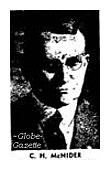 One of these was the six-story First National Bank Building, the first modern office structure in the city, built in 1910.
C. H. McNider was now president with Willis C. G. Bagley and C. A. Parker, vice presidents, and R. P. Smith, cashier.
One of these was the six-story First National Bank Building, the first modern office structure in the city, built in 1910.
C. H. McNider was now president with Willis C. G. Bagley and C. A. Parker, vice presidents, and R. P. Smith, cashier.
Meanwhile other banking organizations had come into existence to the extent that Mason City has six banks. The Iowa
State Bank began doing business July 1, 1900, at the corner of First and North Federal, on the present [1953] site of Buttrey's
women's apparel store. It had a capital of $50,000 and the officers were: G. W. Brett, president; N. C. Kotchell,
vice president; I. W. Keerl, cashier, with J. S. Adams, W. C. Clark, D. W. Telford and R. C. Mathews on the board of
directors. Later Kotchell became president and E. W. Clark, assistant cashier. L. O. Stone, later vice president
of the Commercial Savings, also came into the bank as assistant cashier. The Peoples State Bank started business
in August, 1909, with a paid capital of $50,000 on the corner of the present [1953] Montgomery Ward and Company store.
The officers were: W. R. Fleming, president; John D. Glass, vice president; and H. T. Fuller, cashier.
NOTE: George W. Brett was born in 1848, and died in 1936. Alice A. Brett, his wife, was born in 1851, and
died in 1938.
Nathan C. Kotchell was born in 1858, and died in 1924. Cora (Hicks) Kotchell, his wife, was born in
1863, and died in 1955.
Daniel W. Telford was born November 17, 1851, and died June 3, 1927.
Edward W. Clark was born June 12, 1876, and died November 1, 1964.
All interments were made at Elmwood-St. Joseph
Cemetery.
Started in 1913On Aug. 15, 1913, the Security National Bank
opened its doors for business on the present [1953] site of Baron's apparel store at 6 South Federal, first with a
22 foot front building. John Senneff was president and E. W. Clark, cashier. This made the sixth bank in the city,
more than ample for the city's needs. It wasn't long afterward that the Iowa State was absorbed by the Security National
and some time later the Peoples State was consolidated with the City National. The Mason City Loan and Trust
Company moved in with the Security National. In the meantime the Commercial Savings was outgrowing its space and leased
larger banking quarters on the ground floor of the building across the street to the east, erected by Charles H.
Barber and Ralph S. Stanbery, present [1953] site of Helzbergs. As others sold out, ownership of the Commercial Block
finally rested in Blythe who disposed of the building to Carl and E. V. Franke, who on July 3, 1917, opened in the
building the banking business of the Central Trust Company. The building hence-forth was known as the Central Trust
Building.
Business GrewOther commercial ventures joined the banks in serving the increasing population in
Mason City and growing trade area. Appealing to growing number of customers were such department stores as Damon and
Igou (now Damon's, Inc.). Louis Killigan purchased the store T. R. Glanville had founded in 1894. Later it became
Merkes and is now [1953] Aldens. Manley Brothers had the present [1953] Sears, Roebuck and Company site. Mier Wolf and
Sons skyrocketed a small furniture business started in 1901 with a $500 stock into a giant mercantile organization.
In 1914, Wolf build a furniture store on 214-16 South Federal, to be succeeded in 1923 by its present [1953] large building.
Chapman Brothers operated the furniture store that is now [1953] Davison's. C. V. Shipley had the Sterling
Drygoods on the present Ford Hopkins site. Gildner Brothers, who had started a small store in Nora Springs in 1899, came
to Mason City and opened the headquarters for a group of clothing stores. Nichols and Green were in the shoe business.
Sam Raizes opened a South Federal establishment that expanded into a department store. The Vance Music Company,
started in 1898 by Mrs. Vance, was taken over by her son, John. With the automobile gradually supplanting the horse, petroleum
products became an important business. As gasoline stations went up, livery barns disappeared. Garages took their place,
starting with the Hathorn firm which opened for business in 1906 at First and Washington S. W. Service establishment such
as the Ideal American Laundry and Marshall and Swift were started. The Iowa Hardware Mutual Insurance Company was
started in 1903 by the Iowa Retail Hardware Association. A. R. Sale was named secretary of both organizations and was
in charge of the growing business until 1931 when Roy D. Austin took over the management of the Iowa Hardware Mutual and
Philip R. Jacobson became secretary of the Iowa Retail Hardware Association.
NOTE: Sam Raizes was born in November of 1886, and died in September of 1961. Rose E. Raizes, his wife,
was born May 28, 1888, and died November 28, 1987.
Jessie Vance was born in 1863, and died in 1940. Her husband,
David Guile Vance, was born in 1862, and died in 1933. Their son,
John David Vance, was born June 17, 1889, served as a PH3 in the U.S. Army during World War I, and died November
5, 1964.
Arthur R. Sale was born in 1853, and died in 1942.
All interments were made at Elmwood-St. Joseph
Cemetery.
Roy D. Austin died on February 24, 1963, interment was made at Memorial Park Cemetery.
* * * * * * * * * * * * * * * * * * * * * * * * *
MASON CITY'S AUTO FACTORY
[Section 7, Page 23] Back in 1859, when Mason City was just a few scattered cabins, W. A. Kern started a
broom factory in the village. It was an ambitious undertaking in a new country. But Kern was certain he would find a
steady demand for brooms among the settlers. But one thing was wrong. Iowa's deep black soil was too rich for the
growing of broom corn. Kern's venture had to be abandoned. Since then many important industries have come to Mason
City, brought here by persons as enterprising as Kern or by the dynamic spirit of her citizens who wanted the town to
grow. In this onward rush to get new industries, Mason City was almost certain to get some of which, just as the broom
factory, did not fit this locality or for other reasons could not survive. Found Better Material
One industry that didn't develop as expected was the use of native stone available around Mason City. The development of the
brick and tile industry made a new and more easily handled building material available. As the years went on a number
of manufacturing ventures were launched with a flourish of optimism only to be doomed to defeat.
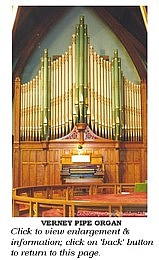 There were, for
instance, the Verney Organ Company, which build pipe organs, the Chase Manufacturing Company, which made gasoline engines
and manure spreaders, and Martin Manufacturing Company, maker of tin ware.
There were, for
instance, the Verney Organ Company, which build pipe organs, the Chase Manufacturing Company, which made gasoline engines
and manure spreaders, and Martin Manufacturing Company, maker of tin ware. It was soon after the turn of the century [1900]
that the Verney Organ Company established a factory here [on First Street S. W.] and manufactured pipe organs. W[illiam]. C. Verney, head of the new
enterprise, had made himself a celebrity in this country and in Europe by building an automaton orchestra, which was
exhibited at the Paris exposition. Forced to CloseThe making of organs got under way, but
the factory operated only a short time, giving up its building [ca. 1915] on 8th S. W. to the Martin Manufacturing Company,
which made heavy tin products and copper ware. This company was started with a flourish of stock selling, but it too,
was forced to close. For a brief time Mason City was the home of a gasoline engine and manure spreader concern, the
Chase Manufacturing Company. This company mapped out an ambitious program that included a purchase of a tract of land,
West Haven, which it subdivided into lots, ostensibly to provide living quarters for its employes (sic). The Chase
building, situated at 200 19th S. W., is now [1953] the Mason City plant of the highly successful Nichols Wire and
Aluminum Company.
NOTE: According to a Globe-Gazette article, March 13, 2012, Verney Organ Company operated in Mason
City for about 10 years. William C. Verney had received a patent on his pneumatic system for organs, called the Verney
Individual Value System. The Verney organ, relocated to Cedar Rapids, was at risk of being dismantled for parts until it
was purchased by the VIVA! Performing Arts School in Dixon, Illinois, where it was installed intact in Philander
Hall, one of the performance venues of the school. Only two other Verney Organs still exist - one in Terre Haute, Indiana,
and the second in Highland, Wisconsin.
Chase Manufacturing Company operated in Mason City from 1913 to 1916.
Had Ambitious PlanIn the magnitude of its conception and the almost startling
potentialities it held, the Colby Motor Company exceeded all other enterprises in this category. The entrepreneur of
this daring enterprise which hoped to make Mason City the automobile manufacturing center of the Midwest, was William
Colby, father of Mrs. Howard O'Leary of Mason City. The company was organized and started turning out automobiles
in 1910. That year was a significant one for it marked a trade revolution in the automobile market. Up to that year
Europe had held a dominant position in automobile manufacture and shipments to the United States exceeded imports.
It was in the midst of this forward surge of the American automobile industry, with scores of factories over the country,
that the Colby Motor Company came into being. William Colby, prince of salesmen, sold stock in the company at $100 a
share. When the company was started in 1910 it occupied a small building near the Mason City Water Works Plant until
its own buildings were constructed at 1305 19th S. W., present [1953] site of the State Brand Creameries, Inc.
[Associated Milk Producers, Inc. in 2014].
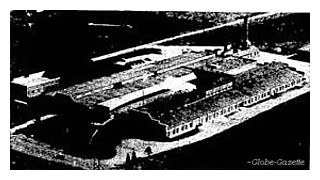 On Nov. 10, 1911, after a year's operation, an eight per cent dividend was declared by the board of directors. Stockholders
and management thought they had a good thing.
On Nov. 10, 1911, after a year's operation, an eight per cent dividend was declared by the board of directors. Stockholders
and management thought they had a good thing. With orders already on hand for the following year's operation for more
than a thousand automobiles and with more than 100 men employed in the plant, it looked like the Colby Motor Company
was here to stay. The construction of the second building took place in 1912 to make room for expanding operations. At the
height of its expansion the plant employed 210 men. The new models for 1912 met instantaneous recognition from the public.
Commendations were coming from buyers in far off places such as New York, Boston and other eastern points. Demand
for the car kept going up. Conducted TestsOutput of the plant was four
cars a day on a year around basis. The No. 60 was the largest car made and sold for $1,800. Others, including roadsters
and touring cars, ranged from $1,400 upward. Top pay at the plant was 35 cents an hour. A Red Seal continental six
cylinder motor was used to power the car. Wheels carried 37 by 5 inch high pressure tires. The tool box was on the
side of the car. Air starters were replaced in 1914 by the electric starter. Winter drives were made by the testing
department of the company to see how the car could be improved for a year around vehicle for this part of the country.
All cars were built by hand, a slow and tedious process. The plant wasn't big enough for an assembly line in the modern
sense. John Nalen was head painter and at that time putting the finish on a car was almost like finishing fine
furniture. The paint was applied, then rubbed down, painted again and rubbed down until the finish looked almost as slick
as the present day job, but far less durable. The Colby plant had its own foundry and manufactured a lot of material
used in building the car, as well as assembling parts that were purchased. One of the innovations in car building
introduced at the Colby plant was an automobile motor machine stand invented by Charles Hathorn of Mason City, now [1953]
engineer with the Curtiss-Wright airplane corporation. This stand held the auto motors while they were being repaired or
installed.
On Race Track
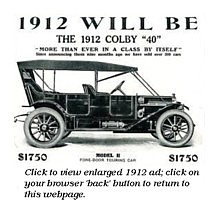 The fame of the Colby car also spread through another medium - the
race track. Races and the breaking of automobile speed records were highly popular in those days and the Colby Motor
Company received its share of publicity on the race track.
The fame of the Colby car also spread through another medium - the
race track. Races and the breaking of automobile speed records were highly popular in those days and the Colby Motor
Company received its share of publicity on the race track. Bill Pearce, race driver, was largely responsible for
advertising the Colby car. His Colby Red Devil racer burned up the country dirt roads and county fair race tracks,
breaking records and gathering press notices until that fatal day in 1914 at Sioux City when he was killed in a race.
That disaster - the death of the daring driver, Pearce - and the wrecking of the Colby Red Devil foreshadowed further
troubles. The competition from Detroit, closer to the source of raw materials and able to put to use mass production
economics, finally sounded the knell of the Mason City enterprise. In [May 26] 1915 the Colby Motor Company went into receivership.
Max Schutz, 1011 Quincy N. W., was the last employe (sic) to leave the once promising plant. He started his employment with
the company June 23, 1911. He worked in every department and served as night watchman for three months after the plant
was closed. Operated Garage
 When Schutz went to work in the factory, he was directly under the supervision of Archie Peterson, then the foreman of
the nickel department. Peterson later operated a garage in Mason City, took a leading part in the pioneering of the
airplane here and is now [1953] with an airplane factor in Wichita, Kan.
When Schutz went to work in the factory, he was directly under the supervision of Archie Peterson, then the foreman of
the nickel department. Peterson later operated a garage in Mason City, took a leading part in the pioneering of the
airplane here and is now [1953] with an airplane factor in Wichita, Kan. Schutz was promoted to the assembly department
and finally to the test department, where Ben Colby, uncle of William, worked. While the company passed on, it left
a valuable industrial property for Mason City. Allan F. Beck purchased the assets of the Colby Motor Company in
receivership for $34,500 in 1917 and sold the plant to the Hawkeye Supply Company, which had been started in 1914 by C. B.
Sherman and G. B. Pray to distribute in North Iowa and southern Minnesota all types of machinery and mechanical
merchandise. Grouped with the Hawkeye Company in the buildings were the Rolfe Iron Company; the Halverson Manufacturing
Company, manufacturers of galvanized troughs; Northern Oil Corporation; and Canners Supply Company, jobbers of cans
and allied products.
The 1911 Colby Model D Semi-racer at the Kinney Pioneer Museum, Mason City,
is the only surviving Colby car. Nearly 1,000 [550 by some accounts] cars were
sold during the company's four years of operation.
NOTE: William Martin Colby was born in Dane County, Wisconsin on March 14, 1875, the son of Colburn
and Annie (Oscar) Colby. He came to Cerro Gordo County, Iowa, in 1876 with his family. He died in 1926 at Mount Pleasant,
Iowa. Mary Agnes (Boyle), his wife, was born June 22, 1876, Luzerne, Pennsylvania, came to Cerro Gordo County in 1877,
and died in 1926. They were interred at St. Patrick's Cemetery, Dougherty.
Mary I. (Colby) O'Leary, daughter of William M. and Mary Agnes (Boyle) Colby, was born June 26, 1900, Mason City,
won many golf tournaments from 1940 to 1960, and died at the age of 97 years on February 18, 1998, Clear Lake.
Her husband, Howard A. O'Leary, Sr. was born December 9, 1891, served as a sergeant in 817 Depot Aero Squadron (Iowa)
during World War I, and died August 19, 1972. They were interred at Elmwood-St. Joseph Cemetery.
William "Billy" Pearce was born December 25, 1876, Pittston, Pennsylvania,
was a former blacksmith, and died during a test run on December 19, 1914. He had competed in 11 races before his death
at the age of 35 years.
Rolfe Iron Company was founded by its president, Charles E. Strickland, born in 1892, came to Mason City in 1936,
and died in 1973.
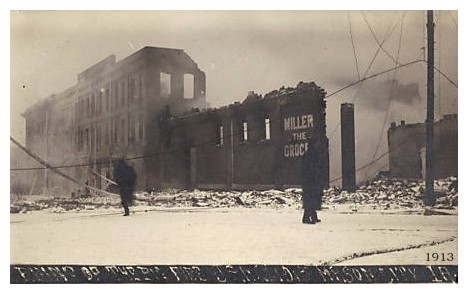
* * * * * * * * * * * * * * * * * * * * * * * * *
MASON CITY GETS FACE LIFTING
 [Section 7, Page 24] The census of 1915 gave Mason City a population of 17,152, entitling it to all the
emoluments and privileges of a city of the first class.
[Section 7, Page 24] The census of 1915 gave Mason City a population of 17,152, entitling it to all the
emoluments and privileges of a city of the first class. The city had leaped forward from 6,747 in 1900 and 11,230 in 1910
to pass the 15,000 population mark required for designation as a city of the first class. On Feb. 16, 1916, it was so
declared by the executive council of the state. At the helm of the city government at this important moment was colorful,
able Mayor Truman A. Potter, who years before had come to Mason City from his native Britt as an associate of B. C. Way
in the telephone business. Spent $1,500,000In the four years that he headed the city
government from 1915 to 1919, Potter directed the most comprehensive municipal face lifting the city has had in 100 years
of history. He and his associates spent $1,500,000 in permanent improvements, most of it going for paving, the building
of a sewage disposal plant and for the construction of bridges. They added more improvements than were made by all previous
city administrations combined. There is no inference in this that previous councils had been delinquent or idle. The
city grew so rapidly that most of the councilmen's attention was directed to providing such necessities as water, sewer and
fire protection for the new additions. It was necessary to keep adding to the fire department. As the new century
started the volunteer Denison hose company was still doing the job. In 1901 J. W. Adams, its chief, was authorized to spend
$1,200 for a chemical wagon. In 1904 he was named fire warden at $200 a year. Built Fire Station
Gradually the department passed into full municipal maintenance and at a special election Sept. 20, 1911, the city
decided by a vote of 337 to 328 to build a fire station. Meanwhile the city was getting other improvements. The
minutes of Jan. 14, 1902, show the municipality petitioned Andrew Carnegie for a gift of $50,000 for a public library.
The following May the council voted to provide a suitable site for a Carnegie donated building, now [1953] the office of the
Iowa Hardware Mutual.
Mason City's Carnegie Public Library, designed by A. Patton and Miller, was
dedicated on January 10, 1905. By the late 1930's, Mason City had outgrown this library. A new [present-day] library
was opened in January of 1940. In 2014, the Carnegie library building houses private businesses.
Other changes were also in the making. The automobile was becoming so much a part of life that
on June 4, 1906, the city council passed a lengthy ordinance regulating traffic for the horseless carriage.
Another RailroadAnd - once more- the building of another railroad into Mason City aroused the enthusiasm
of the community. The old yearning for more rail transportation with all its attendant opportunities for business, industry
and growth was revived and Mason Cityans in 1906 voted 518 to 153 to levy another tax upon themselves. This time it was
a 2 1/2 per cent levy on all property in the city to aid the St. Paul and Des Moines railroad in the construction of its
line from Iowa Falls to Mason City. It wasn't until three years later that the railroad was built, giving Mason City
direct transportation to Des Moines and Kansas City and another route to Minneapolis. In 1913 this railroad became a part
of the Rock Island system. This completed the era of railroad building in Mason City. The city now had five steam
railroads radiating in all directions in addition to the lake interurban. Presents Recommendations
Records show many ambitious projects engaged the attention of city councils the first decade of the 20th century.
At the Nov. 7, 1907, meeting of the council, Mayor James H. McConlogue presented recommendations for a municipal hall,
more parks, safety gates at railroads, reduction of water rates, extension of paving and a uniform system of sidewalk
construction. Several councils did their best to get a city hall. On May 14, 1908, Ray Bogardus, on direction from
the council, presented plans for such a building. But the council was unable to agree on a site. With the growth
of population Mason City began bursting at the seams with the result that on April 30, 1912, the citizens voted
634 to 22 to extend the limits practically in all directions. Took Important Steps
In 1913 Mason City took a step that set the stage for the Potter regime that came two years later. It adopted the
commission form of government. The commission form, which at this time was being voted by many municipalities over
the country, had its origin in Galveston, Tex., following the flood devastation in 1900. Three men emerged from the
crisis, took power into their hands and were supported by the community. They exercised for a time all the powers held
by the city council, mayor, chief of police and police judge. So successful was this expedient that Galveston adopted
the plan permanently and called it the commission form of government. The plan aroused the attention of other cities.
Present PetitionSo it wasn't surprising that on Feb. 17, 1913, a petition signed by 578 persons
was presented to the Mason City council, asking that a special election be called to vote on the adoption of the commission
form. After a bitter campaign an election was held April 12 of that year with the proposition carrying by a majority of
1,135. On the following June 18 three commissioners were elected at large without regard to ward boundaries. In these
three men were concentrated the executive, legislative and judicial powers of city government. John Stanton, who was
serving as mayor at the time of the change, was elected mayor or chairman of the commission. The other two were Harry
E. Stanbery and William E. Miller. The first two years of commission government were largely a continuation of the
previous policies under Mayor Stanton's leadership. Potter ElectedWhen Potter assumed the
office of mayor with G. O. Gould and Lyle P. Kirk as commissioners on April 5, 1915, plans were immediately set in motion
to make Mason City in fact as well as in name a city of the first class. Throughout the four years of his administration,
Potter had Gould with him on the commission. Two changes took place in the office of the other commissioner. On Dec. 13, 1915,
C. A. Cadwell was appointed to fill the vacancy caused by the death of Kirk. In March, 1917, Potter and Cadwell were
re-elected, but Charles Lee replaced Cadwell, who subsequently was named by the commissioners as director of health and
sanitation, building inspector and in charge of public safety. Offices MovedThe first move
of Potter and his associates was to place the city administration on a more businesslike basis. The municipal officers were
moved from crowded quarters in the basement of the courthouse to a store building on North Federal, where also was housed
the police department with a building in the rear fitted out as a jail. On May 5, 1916, the commissioners adopted an
ordinance renaming practically all streets in the city. The only street to keep its old name - a name it was given by the
first settlers - was State Street. Under the new system all thoroughfares running east and west were called streets, north
and south, avenues. Old Main became Federal Avenue. Avenues east of Federal were named for the states in the order
in which they were admitted to the Union. Avenues west of Federal were named for the Presidents of the United States in
the order in which they served. The streets, running east and west, were given numbers to correspond to the number
of blocks they were north or south of State Street. Large Paving ProgramThe biggest street
improvement project, however, was the paving. In four years the Potter regime laid 32 1/2 miles of paving, raising the
city's paving mileage from 15 1/2 to 48 miles, with three more miles on order. A number of important bridges were
constructed, among them three across Willow Creek, one on First S. W. to connect with the viaduct leading to Mercy
Hospital, a second on South Federal and the third, the largest, to replace an old wooden structure on South Pennsylvania.
Build Disposal PlantOne of the special accomplishments of this administration was the erection
of the city disposal plant east of the city at a cost of $153,000. Up to that time the city sewerage had been expelled into
the Winnebago River. Also erected was an incinerator to dispose of the city's garbage. The fire department was
completely motorized and modernized. A system of inspecting stores, factories and public buildings was put into operation.
The police department, in which Mayor Potter took particular pride, was likewise given modern equipment and enlarged
to properly serve the city. A finger print method of identification was started and new uniforms adopted. For the
convenience of produce-men, truck gardeners and the general public, a market house was erected on Washington S. W.
(present [1953] site of the police station) at a cost of $3,000. Improvements and additions were made to the city parks
and a public health department was established.
Water Mains LaidFifteen miles of water mains were laid, bringing the total to 47 miles. The
financing of this giant program was made by special assessment, by raising the city tax levy and by bond issues. The
city tax levy was raised from 37 1/2 mills in 1915 to 51 1/2 in 1919, upping the city's receipts from $109,261.70 to
$182,132.39 in a year. Bonds and certificates outstanding rose from $209,090.05 in April, 1915, to $587,158.13 four
years later. Accounting largely for this increase was a $132,000 disposal plant bond issue, $67,000 bridge fund bonds
issued in 1917, $9,000 in fire fund bonds issues in 1917 and $24,000 in sewer bonds. This four year program which made
Mason City conform in physical appearance to the magic of its growth was not accomplished without opposition. Petitions
objecting to the heavy expenses of paving came in, but they were usually overridden by the commissioners, with Mayor
Potter himself making the motion. Kotchell Named MayorIn the election on March 31, 1919,
Potter endeavored to turn over the mayor's toga to his close associate of four years, G. O. Gould. but it was evident
a reaction was setting in against the furious pace at which city improvements were made. N. C. Kotchell, former
banker, was elected mayor and with him on the commission were Walter Veech and S. A. Koch. The pendulum had swung
back. Its oscillations were to be felt more extensively than ever in the decades ahead.
NOTE: Truman A. Potter, declared to be one of the most successful mayors in Mason City's history,
was born in Lawler, Iowa in 1871, came to Mason City with the Western Electric Telephone Company which he founded with
B. C. and Thomas Way, served as mayor of Mason City from 1915 to 1919 and again from 1925 to 1927, organized Mason
City's Chamber of Commerce in 1916, and died at the age of 60 years in a tragic early morning fire at his residence,
50 Beaumont Drive, in March of 1931.
Joseph W. Adams was born in Rock Island County, Illinois, on November 8, 1862, and died April 25, 1935, interment
was made at Elmwood-St. Joseph Cemetery.
Ray R. Bogardus was born in 1886, and died in 1958, interment
was made at Memorial Park Cemetery.
G. Orlo Gould was born in 1877, and died in 1970. His wife, Harriet N. Gould,
was born in 1889, and died in 1961. They were interred at Elmwood-St. Joseph Cemetery.
Lyle F. Kirk was born
December 28, 1878, the son of Burrows P. and Mary J. Kirk, and died November 9, 1915, interment was made at Elmwood-St.
Joseph Cemetery.
C. A. Cadwell was born September 22, 1870, and died November 4, 1952, interment was made at
Elmwood-St. Joseph Cemetery.
Charles M. Lee was born in 1869, and died in 1948, interment made at Elmwood-St.
Joseph Cemetery.
Nathan C. Kotchell was born in 1858, and died in 1924. His wife, Cora (Hicks) Kotchell,
was born in 1863, and died in 1955. They were interred at Elmwood-St. Joseph Cemetery.
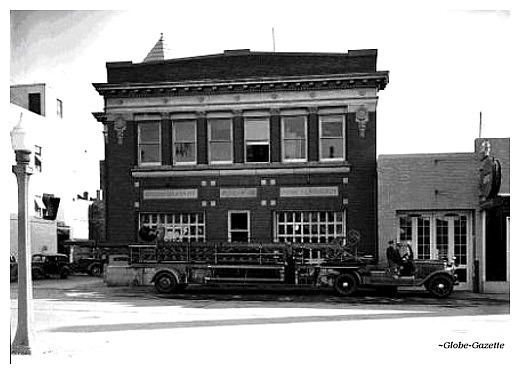
Central Fire Station, Built in 1912
* * * * * * * * * * * * * * * * * * * * * * * * *
THE LIGHT THAT FAILED
 [Section 7, Page 25] The Sons of Union Veterans at their national convention in Syracuse, N. Y., in 1900,
voted to build a university "to commemorate the deeds of loyalty of our fathers and mothers." They decided to build the
"university' in Mason City, Iowa. This action by the convention was a triumph for a group of leading Mason Cityans who had
worked on the project since A. L. Sorter four years before had thought of the fantastic plan of establishing a
"Harvard of the West" here backed by the finances and membership of the powerful veterans affiliate.
[Section 7, Page 25] The Sons of Union Veterans at their national convention in Syracuse, N. Y., in 1900,
voted to build a university "to commemorate the deeds of loyalty of our fathers and mothers." They decided to build the
"university' in Mason City, Iowa. This action by the convention was a triumph for a group of leading Mason Cityans who had
worked on the project since A. L. Sorter four years before had thought of the fantastic plan of establishing a
"Harvard of the West" here backed by the finances and membership of the powerful veterans affiliate.
NOTE: Davenport Times, Davenport, Iowa, Wednesday, June 13, 1900. Adjutant General's Report ~ "Notes on Sons of Veterans":
A. L. Sorter, the senior vice commander-in-chief of the national officers, and junior vice commander of the Iowa
Division is an old newspaper man of much experience, seven years, in fact. He is young in years, but stated that in his
regiment he was captain of company A, 52d Iowa of Mason City during the Spanish-American war. There were 90 out of 100
who were sons of Veterans, although not affiliated with the Iowa Division. Mr. Sorter said also that he was chairman
of the national military college committee, and concerning this proposition he had this to say:
What Sorter Says:
"The most important thing that will come before the S. V. encampment during its present session will be action
relative to Iowa's candidacy for the national military college, which will be located by vote of the national
encampment, at Syracuse, N. Y., in September next. This is a memorial university founded by the order and
dedicated to the memory of the soldiers of the civil war and the noble women of war times. Already about two
million dollars are in sight as an endowment fund and a big fight on location is looked for at Syracuse. Iowa,
however, is going in to win. "The western states are all for Mason City, Iowa, and it is highly probable that Iowa will
win." In the century of its existence Mason City has spent huge sums to provide the best possible
school facilities, but Sorter's ambitious dream stands as the community's mightiest effort to achieve distinction in the
field of education. Those who originated and launched the project were to have the heartbreaking experience of seeing
their dream grow dim and fade away. Assisting Sorter, who was himself a member of the Sons of Union Veterans, were
his father-in-law, H. E. Francisco, James E. Blythe, already recognized for his political organization work, and
many others of the town's leading citizens. As soon as the Syracuse convention gave the "go" signal, incorporation
papers were drawn up for the National Military College Association, with the following officers: J. E. E. Markley,
president; Dr. T. T. Blaise, vice president; C. A. Dyer, secretary; and W. J. Reinke, treasurer.
Corporation FormedThe first action of the corporation was to purchase 160 acres south of
the Milwaukee station. Forty acres were set aside for the university campus and the remainder divided into lots and sold.
Architects drew plans for buildings on the campus, stressing "solitary grandeur and somber impressiveness rather than
beauty." The college campus was to face north with a library and chapel in the center of numerous buildings. The
library was to be in the shape of a Greek cross with a chapel in the rear.
Pledge Card in support of Memorial University
Cornerstone Laid
 "The Day of Jubilee is Here," hailed the Globe-Gazette on June 26, 1901, when the cornerstone was laid for the
college's first building, a structure which today [1953] is the Roosevelt elementary school. The crowd was the
largest ever seen in Mason City up to that time.
"The Day of Jubilee is Here," hailed the Globe-Gazette on June 26, 1901, when the cornerstone was laid for the
college's first building, a structure which today [1953] is the Roosevelt elementary school. The crowd was the
largest ever seen in Mason City up to that time. On Sept. 20, 1902, the widely heralded Memorial University opened
its doors to the youth of America. Then came shocking disappointment and the haunting fear that the fanfare had been
for naught. Only 40 students were enrolled, a considerable number of them from Mason City. But Walter Doran, dean of
the school, showed no pessimism when at the opening exercises he declared that the band of students before him "was small
indeed compared to the thousands that will come." By the end of the first week hopes were renewed as some 100 students
had arrived. When the expected influx of students failed to materialize, the Rev. S. S. Wyant, president of the
university, spent most of his time traveling in search of students and, even more important, in quest of money.
Hired New PresidentWhen Wyant failed to show progress in operation of the school, the trustees
hired another president, Frederick Tucker of Minneapolis. By this time the dream of the "Harvard of the West" and a
campus full of buildings was fading. When Walter Patton was called from Wisconsin as president in 1906 he concentrated
on raising funds, but found the interest of the Veterans organization was fast waning. Sectional differences
played a part. Many of the members had wanted the school in the east. The Class of 1903 had seven graduates. The graduating class of 1909 was the last group
of students to receive degrees from Memorial University. The 1909-10 term closed in midyear for lack of funds. That was
the last of Memorial University. Al Sorter's fabulous dream had come to an end. Classes in 1911
When fire destroyed the high school (now [1953] the Lincoln school) in 1911, classes were moved to Memorial University.
A few years later the Most Rev. James J. Keane, archbishop at Dubuque, bought the building and land for $180,000. In 1918
the Mason City school system purchased the property for $75,000 and converted the building into the Roosevelt grade
school.
Memorial University, ca. 1907
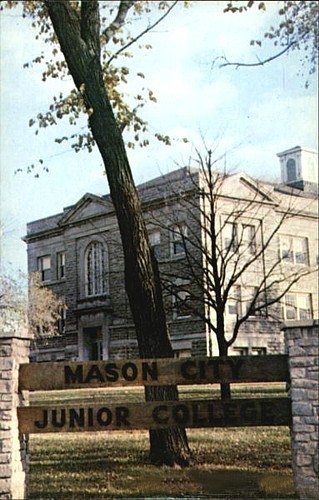 NOTE: In the mid-1950's, Mason City Junior College moved from the high school building and into the newly
remodeled Memorial University Building, located on the Roosevelt School campus. Mason City Junior College occupied
this building for twelve years, then in 1970 moved to a 300-acre site located on the east edge of Mason City. By this
time the college had been renamed North Iowa Area Community College. The Memorial University building was torn
down in 1979.
NOTE: In the mid-1950's, Mason City Junior College moved from the high school building and into the newly
remodeled Memorial University Building, located on the Roosevelt School campus. Mason City Junior College occupied
this building for twelve years, then in 1970 moved to a 300-acre site located on the east edge of Mason City. By this
time the college had been renamed North Iowa Area Community College. The Memorial University building was torn
down in 1979.
Al L. Sorter left Mason City and relocated in Minneapolis, Minnesota
 Rev. Walter J. Patton was born in Norristown, Pennsylvania on July 7, 1856, the son of John R. Patton who had served three
years in Co. K of the 109th Pennsylvania Infantry during the Civil War. Rev. Patton was ordained in 1877, Philadelphia, and
went to Wisconsin the same year. He served as Commander of Sheboygan's Carl Witte Camp #37 in 1892 and was appointed
Department Chaplain in 1894. As National Patriotic Instructor, Rev. Patton was called to the presidency of Memorial
Union and, despite being unable to raise the necessary funding, he was able to keep the school open for four years.
After the university closed, Rev. Patton remained in Mason City for another year to see the school liquidated, then
returned to Wisconsin, moving to Berlin, Wisconsin in 1925. He retired from the ministry in 1929 and died at the age of
87 years on December 30, 1943, interment made at Masonic section of Riverside Cemetery, Oshkosh, Wisconsin.
Rev. Walter J. Patton was born in Norristown, Pennsylvania on July 7, 1856, the son of John R. Patton who had served three
years in Co. K of the 109th Pennsylvania Infantry during the Civil War. Rev. Patton was ordained in 1877, Philadelphia, and
went to Wisconsin the same year. He served as Commander of Sheboygan's Carl Witte Camp #37 in 1892 and was appointed
Department Chaplain in 1894. As National Patriotic Instructor, Rev. Patton was called to the presidency of Memorial
Union and, despite being unable to raise the necessary funding, he was able to keep the school open for four years.
After the university closed, Rev. Patton remained in Mason City for another year to see the school liquidated, then
returned to Wisconsin, moving to Berlin, Wisconsin in 1925. He retired from the ministry in 1929 and died at the age of
87 years on December 30, 1943, interment made at Masonic section of Riverside Cemetery, Oshkosh, Wisconsin.
SOURCE: suvcw-wi.org/dc_bio/patton_walter.html
While Mason City was engaged in this effort to establish a university, a rapid expansion of the city's public
school system took place. The voting of bonds and construction of buildings was not without some interesting incidents.
When the Lincoln school was built in 1904 to serve as a high school a legal limit made it impossible to bond the district
for the full amount with the result that the school stood without a roof until warrants were issued for completion of the
structure at a total cost of about $75,000. In 1900 four rooms were added to the Garfield school, making eight rooms.
The same year the Grant school was enlarged and with the influx of workers at the brick and tile plants another
addition was built in 1912. McKinley Built
In 1910 the first unit of the McKinley school was
built at 1510 North Federal to serve the cement plant and Decker districts. The building was enlarged in 1913 and again
in 1920 for a total cost of $156,000. The Jackson school at 1809 South Federal, since sold to a commercial concern,
was built in 1913. That year also saw the completion of the Manual Arts Building on the Central School grounds for
$22,000. On Aug. 29, 1911, the school board received a petition asking [for] a special election to vote on
bonding the district for $175,000 for a new high school. At an election on Oct. 10, 1911, the proposition was defeated.
Meanwhile the board had another school problem. The Lincoln school was destroyed by fire. [The building was
struck by lightning which caused the fire.] While classes were moved to Memorial University, plans went ahead for rebuilding.
As far as is known this was the only time the school district
made money on a fire. The insurance companies paid the district for a complete loss. By hiring a superintendent the
board succeeded in rebuilding at a lesser figure. Sought InjunctionWhen the building was part
way up, suit was brought against the district, seeking an injunction against proceeding without competitive bids. The
case was tried before Judge J. J. Clark in the district court. Judge Clark allowed construction to proceed to a
point where a roof was provided for the protection of the heating system and then ordered the board to take competitive
bids for the remainder. The result was a net saving to the district of several thousand dollars.
Agitation developed for a new high school. At a special election on Jan. 18, 1916, a proposal to bond the district
for $250,000 for a building carried 751 to 594, but a $35,000 proposal for a site lost 716 to 587. On March 20, 1916, a
petition was presented asking for an election on April 21, 1916, to vote on purchasing the half block now [1953] occupied
by Radio Chapel and St. John's Episcopal Church and bonding the district for $39,000 to make the purchases. The proposition
lost by the narrow margin of 1,096 to 1,013. On May 31, 1916, a citizens committee suggested [the] purchase of the half
block east of the old library building (Iowa Hardware Mutual). On July 7, the citizens of Mason City voted 414 to 282 to bond
the district for purchase of this site. The next day the board started condemnation proceedings to acquire the property.
The following October the general contract for the high school was let to H. F. Jones of Cedar Rapids for $194,000. By the
summer of 1918 the building was completed.
Opposed PurchaseWhile engaged in the struggle to get the high school erected the board was
virtually deluged with requests for grade schools in new additions. On Aug. 21, 1916, a petition was presented for a
school "east of Kentucky." On the following Sept. 23 the vote was 249 to 33 for a bond issue of $38,000 to build the
Jefferson school. A four to three division on the board came up in the proposal to purchase the Memorial University
building and nearly 30 acres of ground. Allan Beck obtained an option from Archbishop Keane at $75,000. He with Willis
Bagley and Frank Goodman favored the purchase, but were bitterly opposed by the other four. The matter came to a head
with the presentation on Jan. 24, 1917, of a petition signed by 300 voters, proposing a $75,000 bond issue to make the
purchase. At the special election the following September the vote was 755 to 157 for the bond issue. On Jan. 29, 1918, Mason
Cityans decided by a vote of 168 to 93 to add $55,000 in bonds for the remodeling of the building.
Unable to complete the contract. The board took over the contract, hiring Jones as superintendent. Meanwhile a campaign
by the Parent-Teachers Association for free textbooks was gaining momentum with the result that at a special election on
March 18, 1918, the vote was 1,347 to 383 to provide pupils with books paid for by the schools. Starts
Junior CollegeWhile the building of schools took place Mason City continued internal improvement of the
system. No sooner had the Iowa legislature passed the law then Mason City established a Junior College, the first in the
state. In the fall of 1918, college work started in the newly completed high school, with the first and second year
instruction and an enrollment of 28 students.

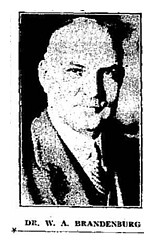 Mason City can point with pride to the fact that a number of those who
directed its school system rose to national prominence. Among those was John W. Studebaker, principal of Kansas
City Teachers College, the second Mason City School man to head a teachers college.
Mason City can point with pride to the fact that a number of those who
directed its school system rose to national prominence. Among those was John W. Studebaker, principal of Kansas
City Teachers College, the second Mason City School man to head a teachers college. On July 17, 1918, F. T. Vasey was
named superintendent of schools, coming here from Charles City. Under his leadership and that of James Rae, principal of
the high school, the Mason City schools system received wide recognition.
* * * * * * * * * * * * * * * * * * * * * * * * *
CHURCHES REACH FACTORY WORKERS
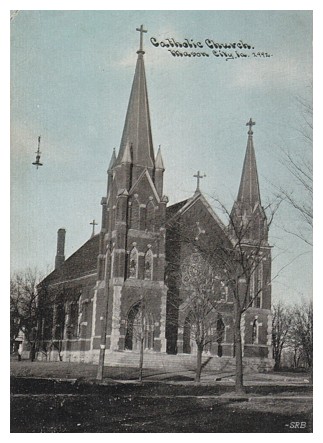
[Section 7, Page 26] As the factory worker went farther and farther from the center of the city to build
his home due to the rapid growth of population, he was followed not only by schools, but also by opportunities for
religious worship. The First Methodist Church, with its building paid for and membership growing, became the leader
in this decentralization of church activities by sponsoring two outposts in opposite ends of the city, building the
Calvary [Methodist Episcopal] at 1615 Delaware N. E. and the Olivet Church at 20th and South Federal. The Olivet proved
[to be] the beginning of the present Wesley Methodist Church, while Calvary is now the place of worship for the Assembly
of God. To Serve Workers
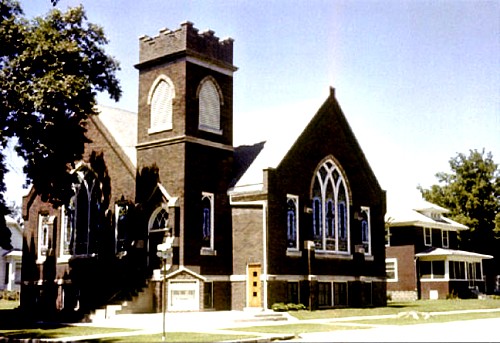 Another church that was started to serve the workers in the Decker an
cement plant area was the Grace Evangelical. This church was erected at 14th and Adams N. W. at a cost of $12,069.01 and
dedicated Dec. 23, 1913. As was customary in those days the completion of the church was followed by a revival meeting that
added many new members.
Another church that was started to serve the workers in the Decker an
cement plant area was the Grace Evangelical. This church was erected at 14th and Adams N. W. at a cost of $12,069.01 and
dedicated Dec. 23, 1913. As was customary in those days the completion of the church was followed by a revival meeting that
added many new members. The influx of laborers to the cement plants and brick yards soon included immigrants from the
Balkans - Greece, Yugoslavia and Bulgaria. The first person of Greek descent to arrive was Gus Skondras, who came in 1905.
By 1908 a considerable number were part of the community.
The Greek Orthodox Church at 14th and Washington N. W. was erected in 1915 under the leadership of George Marinos, James
Farmakis and Pete Karamitros, the latter having just returned from a three year visit to Greece during which he fought
against the Turks. Three lots were purchased for $1,800 and Hugh Davey built the church at a cost of $13,000. The young
men of the congregation dug the basement and the cement plants provided mule teams to haul away the excavation. The
brick yards contributed material and money. Until the church was build services were held in a basement room of the
courthouse. NOTE: George P. Marinos was born in 1886, and died in 1982. Irene Marinos was born
in 1892, and died in 1941.
Peter K. Karamitros was born in 1884, and died in 1950. Antigone P. Karamitros was
born in 1892, and died in 1970.
Hugh Davey was born in 1870, and died in 1936. Mary E. Davey was
born in 1875, and died in 1972.
All interments were in Elmwood-St. Joseph Cemetery.
Largest Project
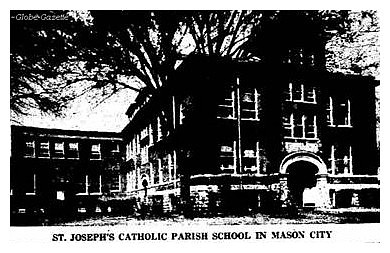 Largest church building project of these first years of the new century was the St. Joseph's Catholic Church and school. The
present [1953] large brick church was erected in 1901 under the direction of the pastor, Father Michael Carolan, replacing
a church that was built in 1871 at a cost of $2,000.
Largest church building project of these first years of the new century was the St. Joseph's Catholic Church and school. The
present [1953] large brick church was erected in 1901 under the direction of the pastor, Father Michael Carolan, replacing
a church that was built in 1871 at a cost of $2,000. The new St. Joseph's Church was part of a wave of church building
that got under way in the later 90's. It proved for the rapidly increasing membership that has grown from 52 families in 1878 to
500 families at present [1953]. Succeeding Father Carolan was the Rt. Rev. Msgr. P. S. O'Connor who served the parish
from 1918 to 1944 (sic, should be 1945), being succeeded by Father P. J. Behan and since 1947 by Rt. Rev. Msgr. P. F. Malone. The church
has undergone redecorating a number of times and in 1950 and 1951 the exterior was completely refinished and the interior
remodeled to include a new sanctuary, altars and pipe organ. In early 1953, for the first time, the basement of the
church was completely excavated and made into an auditorium. The St. Joseph's cemetery was established in 1875 and was
enlarged in 1932. NOTE: Father Michael Carolan was born December 2, 1844, and died December30,
1917. Monsignor P. S. O'Connor was born in 1863, and died in 1945. They were interred at Elmwood-St. Joseph Cemetery.
St. Joseph Cemetery and Elmwood Cemetery were both deeded to the city in 1949, hence combined to create Elmwood-St.
Joseph Municipal Cemetery. Build Parish SchoolIn 1909 the St. Joseph's
parish school, erected at an initial cost of $35,000, was opened with the Presentation Sisters from Dubuque in charge of
teaching under the direction of Sister Mary de Pazzi. The school replaced the St. Francis Academy, a three-story red brick
building. The academy, which was started in 1878, had a large number of out of town students. In 1919 the school was
remodeled at a cost of $14,000 and other improvements have been added since. In 1920 the shcool was accredited by the
Iowa commission on secondary schools and colleges. In 1927, due to increased enrollment a new wing was built on
St. Joseph's school costing $75,000. This is now [1953] the present high school and auditorium. Organize
Holy FamilyWith the increase in numbers of the Catholic faith the Most Rev. John J. Keane, archbishop
of Dubuque, appointed Rev. E. J. Dougherty the first pastor of the new Holy Family parish in Mason City. In October,
1908, the first mass for the Holy Family parishioners was offered in the Mason City public library. Construction of a
church took place in 1909 on 2nd N. W. near Washington. This church served the congregation until the erection of the
new church in 1950. In the summer of 1918, after the transfer of Father Dougherty to Oelwein, the Rev. R. P. Murphy of
Clarion was appointed to the Holy Family parish. He served the parish for three decades. NOTE:
Monsignor Edward J. Dougherty, the son of Daniel and Mary (Gallagher) Dougherty, was born August 27, 1868,
ordained December 27 1892, and died at the age of 83 years on March 2, 1951, Waterloo. Interment made at St. Patrick's
Catholic Cemetery at Dougherty, Iowa. Presbyterians StartMeanwhile population
increase brought other churches. On Jan. 5, 1905, the First Presbyterian congregation was organized and the first
services held at the courthouse. In 1908, the Rev. LeRoy C. Cooley Jr. of Rowley took over the pastorate, after
which the construction of the church at 9th and Washington N. W. got under way. The cornerstone was laid Aug. 2, 1908,
and on Dec. 20 of that year the first services were held in the new building. The congregation then had a membership of
70. At the annual meting on April 4, 1913, the congregation became self-supporting with a membership of 142. In 1915
the church established the East Side Presbyterian Church, another effort to reach the new additions in the city. This
church at 1056 Maple Drive, is now [1953] the First Convenant Church. New Lutheran Church
As more Lutherans moved into the city, additional groups of that faith became represented in the churches of the city.
In 1914 the Immanuel Lutheran Church was organized. Services the first year were held at Trinity Church, where many
of the members had previously been affiliated. A lot was purchased at First and Jersey S. E. for $2,250 and a chapel
built which served the congregation until in 1922, when under the leadership of the Rev. O. A. Elmquist, field missionary
of the conference, plans were set in motion for the present [1953] church in 1923. In 1924 the parsonage was erected.
Built First ChurchBy the turn of the century the First Church of Christ, Scientist, had become
strong enough to construct a church. In 1901 a church was built on the east end of the present [1953] church property at
Washington and Third N. W. The first service was held in this chapel Aug. 4, 1901. The building was a simple white
frame structure. The deep entrance with four pillars supporting the porch extended across the front. The organ and
readers' desks and chairs of varnished oak stood on a simple platform at the south end of the room. Plain wooden-chairs
provided for a congregation of 125. This church was to give way in the early 20's to the present [1953] new modern
church structure. Union Memorial StartedWith the growth of the Negro population here
the Union Memorial Methodist Church was organized Feb. 25, 1912, with seven members and a membership of 29 Sunday
School children. Under the leadership of the Rev. F. D. Woodford, a lot was purchased at 4th and Carolina N. E.
Members of the congregation dug out the rock and laid the foundation for the church, which was dedicated in November, 1913.
Meanwhile the St. James Lutheran Church continued its growth. The congregation, organized in the 90's, was served from
1892 to 1912 by the Rev. John F. Larch, then by the Rev. A. F. Karsten until 1914. The Rev. Oswald E. G. Mall set a
record for ministerial service in Mason City as pastor of St. James from 1914 to 1943. Bethlehem Organized
Meanwhile another Lutheran church body that had its origin among those of German descent in America became
represented in Mason City. The Bethlehem Lutheran Church of the Wisconsin Synod was organized here in 1916 with the
first services conducted by P. E. P. Beyer, who became the resident missionary of the congregation. In September, 1917,
the Rev. P. H. F. Buettner of Hampton was called. The congregation was first housed in a chapel at 16th and Delaware
N. E. In 1925, the Rev. C. A. Hinz began his pastorate. Under his leadership the property at Delaware and 5th N. E.
was purchased and the former Christian Science chapel moved to the site to serve the congregation until the erection of
a new building. In 1940 the congregation became self-supporting and in 1951 built the new church. Provided with
ample building facilities the First Congregational Church continued to add to its membership. The parsonage at
221 3rd N. E. built in 1915, was the gift of Mrs. Mayne Denison Keeler in memory of her parents, Mr. and Mrs. O. T.
Denison, who had been active leaders in the church. Jewish CommunityThe building of a
Jewish community in Mason City started with the arrival of Mier Wolf and family from Cedar Rapids in 1898. In 1902
the Frank Kropman family moved here, followed by the Sam Woldman, Morris Shulman and Wilham Larger families.
By 1908 there were a sufficient number of families to support a rabbi and that year Rabbi Isaac Schultz of Chicago
came to Mason City and organized the Adas Israel congregation. In 1910, a small synagog was built at 621 Adams S. W.
The charter members were Mier Wolf, Frank Kropman, Sam Woldman, Morris Shulman, William Larner, Morris Miller, T. Benblit,
Sam Kitsis, Herman Goldstein, Louis Tokman, Sam Garfin, J. Friedman and William Alter. Rabbi Schultz was succeeded
in 1915 by Rabbi Simon Levinson. In 1929 Rabbi Schultz returned to find the Jewish community increased to 35 families.
As the synagog grew Rabbi Schultz was retained for the more orthodox member and a more modern rabbi for the younger
members. NOTE: Mier Wolf was born in 1871, and died in 1938.
Rose Woldman was born in
1879, and died in 1968.
Sam Garfin was born in 1905, and died in 1979. Florence Garfin was born in 1908, and
died in 1994.
Adas Israel Shul is located at 7th and Adams, Mason City.
Organized in 1909The Adventist Church was organized in 1909 and the present [1953] church
at 1416 Delaware S. E. erected in 1911. Pastor Will McComas was serving the congregation at that time. The Salvation
Army continued to carry on its joint program of ministering to the spiritual and physical welfare to those in need,
using as headquarters a building on South Federal. Organization of the YWCA was first conceived here in 1913 when a
group of young business women wrote to the national organization, asking to have a representative sent to Mason City.
Out of this grew a survey showing 800 wage earning women in the city, 300 of whom were living away from home. A
campaign was conducted, raising $3,300, for which the H. I. Smith property on Adams and State was purchased. This
had rooms for 10 girls, one club room and a cafeteria. A campaign for funds for a new building then got underway and
on Nov. 24, 1918, the new structure was dedicated. Discussion of plans for a YMCA took place, with a group of
women raising funds to purchase a lot, but the building wasn't to come until 1927.
* * * * * * * * * * * * * * * * * * * * * * * * *
THE MELTING POT BOILS OVER
 [Section 7, Page 27] The crying need for labor to man giant new industries turned Mason City into a
melting pot of nations.
[Section 7, Page 27] The crying need for labor to man giant new industries turned Mason City into a
melting pot of nations. Immigrants from a score of countries flowed in to work in the cement, brick and tile, sugar,
and packing industries, raising the number of nationalities toward the 40 mark and bringing a blending of many colorful
cultures. Previous to this period Mason City had been settled largely by persons of North European descent, with a
predominance of German, Scandinavian, Irish, English, Scotch and Dutch stock. After the American Crystal Sugar Company
was started a group of German Russians were brought here from Lincoln, Neb., to work in that plant. They were provided
lots at $150 each along "sugar beet row" but many of them built homes in other sections. In Main Stream
The main stream of newcomers, however, in this period, included such peoples as the Montenegrin, Serbian ,
Croatian, Bulgarian, Greek, Italian, Mexican and an increase in the Negro population. The result was that a new
ingredient was added to the social, religious and cultural life of the city. Many of these South Europeans brought with
them centuries old customs and traditions, the outgrowth of a civilization that for thousands of years had sunned itself
on the banks of the Mediterranean. Mingling with the less emotional population strains already established here, these
newcomers provided the source of a rich new community life. Their children distinguished themselves in the arts, as well
as in other achievements. It Boiled Over
Along with the traditions and customs from Southern Europe there also came vendettas and feuds, which often made the
melting pot boil over. Most of the newcomers were persons eager to establish homes and to become American citizens.
Coming as they did from villages where their families had lived for centuries, they found American ways strange. They found
that life could be a struggle, even in the land of opportunity. With longing for their old homes strong in their hearts,
not knowing the language, nor the ways of America, these people sought out their own leaders to advise them when problems
came up. In trying to do their best to avoid it, they often ran into trouble. Chose Leaders
 Among the early leaders, particularly among the Hellenic peoples, was Peter Karamitros. A person who from the first
was interested in the welfare of his people, Karamitros became adviser, interpreter in court and mediator in other
contacts with local people.
Among the early leaders, particularly among the Hellenic peoples, was Peter Karamitros. A person who from the first
was interested in the welfare of his people, Karamitros became adviser, interpreter in court and mediator in other
contacts with local people. NOTE: Peter Karamitros died at the age of 65 years on December 3, 1950.
Interment was made at Elmwood-St. Joseph Cemetery.
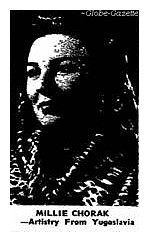 Among the Yugoslavian people there was big, powerful, Nicholas Nigomir, whose daughter, Millie Chorak, became adept in
the art of painting and decorating.
Among the Yugoslavian people there was big, powerful, Nicholas Nigomir, whose daughter, Millie Chorak, became adept in
the art of painting and decorating.
NOTE: Nicholas S. Negomir was born in 1888, and died in 1962. Amelia (Knezevich) Negomir was born in 1880, and
died in 1948. Millicent "Millie" (Negomir) Chorak was born April 5, 1919, Mason City, and died at the age of 77 years on
August 5, 1996. They were interred at Memorial Park Cemetery.
While most of these newcomers were endeavoring to find their places in the community, a few of their number made trouble
for the law enforcement officers. Shootings and stabbings became a not uncommon occurrence in the centers where these
immigrants gathered. One of the meeting places in the stormy decade of 1910 to 1920, when Mason City was endeavoring to a
assimilate its new and rapidly expanding population, was Jackson S. W., then known as Powder Street, the city's own
little Barbary Coast. Nearly every type of crime listed was committed at one time or another on Powder Street in
this decade. when prohibition came, liquor violations were added to the long list of major and petty crimes.
Was Best Known
Through the pages of the bloody history of Powder Street stalked many notorious characters. Best known was dark, once
handsome Walter Myuscovich, from Montenegro, now part of Yugoslavia. Myuscovich came to Mason City Oct. 1, 1922, as a
section worker on the Milwaukee Railroad. He lived back of Mary Sakal's boarding house at 714 Powder Street.
Among the first persons he met was Andrew Cheleovich, who showed him a gun that he carried. When Myuscovich warned him
against carrying a gun Cheleovich became angry and from then on held a deep hatred toward him. This enmity reached a
climax on the afternoon of Dec. 22, 1911, when Walter was seated in Mrs. Sakal's kitchen. He heard a rumpus in the
front room and on investigating found a group of six or seven men, including Cheleovich, engaging in throwing out his
friend and roommate, Andrew Markovich. Myuscovich went to the defense of his friend. In the melee that
followed he lashed out with a knife. When he was in the clear he found Philip Juroich lying on the floor with a knife
through his heart. Philip Socha had a wound in his chest. Cheleovich then drew his gun and fired at Myuscovich
several times as he left the room, but none of them took effect. Myuscovich, realizing he was in trouble, left for
a friend's house and there called the police to come and get him. In the trial that followed the young immigrant was
sent to the Anamosa Reformatory to serve an eight year manslaughter sentence. That was in March, 1912. Three
years later he returned to Mason City on parole, again to become embroiled in Powder Street's tragic drama.
Staged PartyOn the evening of May 3, 1919, the Bohemian Club was staging a party in the
coffee house at 6th and Jackson S. W., one of the social centers of Powder Street days. Walter Myuscovich
was serving as waiter. In the course of the evening he got into an argument with Steve Ivanovich and slapped him in
the face. A few minutes later as Myuscovich was walking toward the cash register Ivanovich whipped out a pistol and shot
him in the back. Taken to Park Hospital, Myuscovich was found to have been critically wounded, but recovered
to the amazement of physicians. Tried for AssaultIvanovich was tried on the charge of
assault with intent to commit murder and was acquitted. The three chief witnesses for the state in this trial were
George Marish, Vedo Bjolobrkovich and Pete Georgeovich.
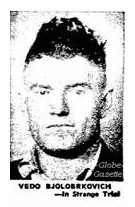 By a strange quirk of fate these three were to be the principals in another tragedy two years later when two of
them went on trial on the charge of murdering the third. And again, Myuscovich was a part of the act, depicted by
the defense as the real villain.
By a strange quirk of fate these three were to be the principals in another tragedy two years later when two of
them went on trial on the charge of murdering the third. And again, Myuscovich was a part of the act, depicted by
the defense as the real villain. The trial of Vedo Bjolobrkovich and George Marish for the death of Pete Georgovich
was one of the most controversial legal battles in local criminal history. It was the outcome of an affray on the
evening of Feb. 13, 1921, near the coffee house on Powder Street. Bjolobrkovich and Marish became involved in an
argument with Myuscovich. When Georgeovich endeavored to intervene he went down in the melee only to have
Bjolobrkovich and Marish fire shots into his prostrate body. Got Legal Talent
Believing that Bjolobrkovich was the victim of the pernicious cunning of his associates, B. C. Keeler, head of the
Mason City Brick and Tile Company, where Vedo was employed, helped get legal talent to defend him. What provoked
this shooting was never cleared up in the long trial that followed. Bjolobrkovich and Marish were allied to each
other in an old Montenegrin "proberton," a pact in which both men swore to uphold the other in a dispute no matter
whether he was right or wrong. The jury decided Pete's death as not murder and returned a curious verdict - guilty
of assault with intent to commit manslaughter. The two defendants were sentenced to five years in prison, but appealed
their case. They were finally free men with suspended sentences. Neither served time on the sentence.
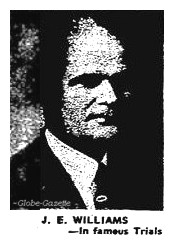 Another curious aspect of the trial was the array of attorneys. It had become the custom for John A. Senneff to
assist the county attorney on the prosecution of big murder trials, while J. E. Williams handled the defense.
Another curious aspect of the trial was the array of attorneys. It had become the custom for John A. Senneff to
assist the county attorney on the prosecution of big murder trials, while J. E. Williams handled the defense. This time
Williams aided County Attorney Ralph Stanbery in the prosecution, while Senneff, with the aid of L. R. Boomhower, handled
the defense. Most Sensational TrialProbably the most sensational murder trial of this
strange decade of dynamic growth was that of Nick Grba, who was convicted of the murder of Mike Baldizar near the cement
plants. The evidence showed that Baldizar was murdered by a charge of dynamite, while entering his garage the night of
Oct. 20, 1920 [other accounts give the date as August 21]. The charge was set off by Grba concealed some distance away with a battery and a wire. No sooner was
Grba behind the prison walls of Fort Madison when he and his attorney, J. E. Williams, and his devoted brother, Eli Grba,
set up a ceaseless battle to release the prisoner who ever maintained his innocence. Their efforts were in a measure
rewarded when in June, 1923, the case was reversed by the supreme court and Grba was brought back to Mason City for
a second trial. Grba was found guilty a second time and sent back to Fort Madison on a life sentence. Two years later
Eli made out a petition to the governor for a commutation of pardon for his brother. This petition, bearing 250 names,
was ready for presentation when Grba suddenly died of pneumonia. Powder Street is today two rows of peaceful homes,
shaded by large trees. These races of people that had among them the trouble makers of the decade between 1910 and 1920,
have been gradually assimilated and today they constitute some of the finest of Manson City's citizens.
NOTE: Mike Baldizer was a cab driver and lived with his wife Anna. Upon returning home after driving
a customer to his destination, Baldizer parked his car in the garage. Within a matter of seconds, the garage exploded and
Baldizar was severely injured. He died a few days later on August 24th. Police, who had arrived upon the scene quickly
after the explosion discovered wires leading from the Baldizer garage to a spot some 30 yards away. They sealed off the
vicinity, waited until daylight and the arrival of Gyp and Pansy, a couple of bloodhounds from Waterloo.
At first Gyp and Pansy went in circles. Finally the dogs picked up a scent that led down a street, across a ditch,
over some railroad tracks to the main plant of Lehigh Portland Cement Company. The dogs continued on the scent toward
some clay pits and stopped at a steam shovel where Nick Grba had left a pair of overalls.
By the time the dogs
had made this discovery, Grba was already in police custody based on several threats he had made against Baldizer, threatening
harm against him because Anna Baldizer, with whom Grba was having an affair, refused to leave her marriage for him.
Witnesses had also placed Grba at the scene of the crime. Other witnesses confirmed that Grba had purchased the items
needed to make the dynamite bomb a few days before the blast occurred. Gyp and Pansy were taken to the police station
where the dogs picked Grba, by scent, from a group of men who walked by them. Grba's conviction was reversed by the
supreme court because, as the court ruled, "The life and liberty of any citizen should not be placed in
jeopardy or be forfeited upon evidence of the conduct of a dog." Hence the evidence, as produced by Gyp and
Pansy, was ruled as inadmissible. SOURCE: malefactorsregister.com/wp/?tag=bomb
Nick Grba was born in 1896, and died in 1927. Eli Grba was born in 1888, and died in 1967.
They were interred at Elmwood-St. Joseph Cemetery.
* * * * * * * * * * * * * * * * * * * * * * * * *
MASON CITYANS HELP DEFEAT KAISER
[Section 7, Page 28] A brilliant moon lights up the ugly gashes that are trenches in the Chamois sector of
Lorraine, France. It is 4:30 - an hour before dawn of March 5, 1918. In the trenches silent sentries scan anxiously the
contours of No Man's Land for the attack they know is coming. Suddenly the whole north seems to rise up in flame and
hurls itself forward. With a thunderous roar it falls upon the Chamois, raining steel and destruction. The earth trembles
with the concussion of bursting shells that churn the trenches into gaping craters. Thus was the German high command's
murderous answer to the report the Americans were there. The 15th Bavarian Sturm Battalion had rehearsed for the maneuver
and Hindenburg himself was waiting to review the attacking troops and to parade the Yankee captives. Enemy
Repulsed
WAR'S FIRST CASUALTIES
Mason City's first casualties in World War I were
Robert Clausen and Clifford J. Worden,
two of the 128 men drawn from National Guard Companies in Mason City to fill out
the ranks of the 168th Infantry for immediate embarkation to France in 1917.
In the first battle on historic March 5, 1918,
these two were killed.
Named in their honor is Clausen-Worden Post of the American Legion.
The proud Bavarians were repulsed, but the American suffered heavy casualties. One shell landed
on a Stokes mortar crew and wiped out the entire group of seven. Among them was Clifford J. Worden of Mason City. Seventy-five
feet away, almost at the same instant, Robert Clausen, another Mason Cityan, was killed. Taking part in the first battle
fought by the 168th regiment of the Rainbow Division in World War I, Worden of Headquarters Company and Clausen of D
Company were Mason City's first casualties in that great struggle. Clausen and Worden, from whom the local post of the
American Legion was afterwards named, were among 128 Mason City men to reach the front with the famous Rainbow Division.
They and their buddies had been members of A and D Companies of the 2nd Iowa Infantry of the National Guard, which had
returned from Mexican Border duty in March, 1917. Called Into ServiceWhen war was declared April
6, 1917, the two companies were immediately called into service and stationed at the armory awaiting orders. E. W. Clark
replaced J. M. Heffner as captain of D. Company, while Capt. Ory W. Garman continued as D Company Commander. On the following
Aug. 16, 68 members of A Company drawn by lot, entrained for Camp Dodge, transferred to A Company of the 168th Infantry.
 Four days later in a similar scene 60 men from D Company went to Camp Dodge, bringing D Company of the 168th to
battle strength. Commander of D Company was a Mason Cityan, Capt. Glenn C. Haynes, who was to distinguish himself in the
long, bloody campaign ahead. A few of the Mason Cityans were transferred to Headquarters Company.
Four days later in a similar scene 60 men from D Company went to Camp Dodge, bringing D Company of the 168th to
battle strength. Commander of D Company was a Mason Cityan, Capt. Glenn C. Haynes, who was to distinguish himself in the
long, bloody campaign ahead. A few of the Mason Cityans were transferred to Headquarters Company. Sailed
Oct. 18On Sept. 10, 1917, the regiment left Des Moines for New York,where it was assembled into the
42nd Division, named Rainbow by Col. Douglas McArthur, then chief of staff, because it was made up of units from 26 states.
The division sailed for France Oct. 18. The remaining members of A and D Companies here were then transferred to Camp
Cody, N. Mex., where they were stationed for a year. On Aug. 31, 1918, the Mason Cityans at Camp Cody, having been made
members of the 125th Machine Gun Battalion, entrained for Camp Dix, N. J., where they were fitted out for overseas.
They sailed for France Sept. 16, landing at La Havre and then taken to Bordeus, from where they were scattered as replacements
on the whole front. Capt. Clark became the head of a train detachment. Thus it came about that on this historic March 5 these
Mason Cityans were in the front lines, an infinitesimal segment of a giant concentration of millions of muddy, battling
men who lived and died in trenches stretching across France and Belgium. Record of Heroism
The history of the 168th in this war was a record of almost unbelievable heroism, bloody encounters and human endurance, in
which A and D Companies took their full share. In May they underwent the horrors of gas attack, with the result that when
they emerged from the trenches in Lorraine the 168th had suffered more casualties than the three other regiments of the
division combined. Capt. Haynes, later named auditor of state, executive secretary of the Iowa Good Roads Association
and then [1933] warden of the state penitentiary at Fort Madison, was promoted to major and awarded the distinguished service cross
for his repeated acts of bravery and fine leadership. Another Mason Cityan, Pvt. Albert Dernek, also of D Company, received
the bronze star.
NOTE: Col. Glenn Haynes was born August 25, 1875, Centerville, Iowa, and served during the
Spanish-American War with the Iowa 50th Infantry. For his actions during the battle of Bois de Chatilon in October of 1918,
Col. Haynes earned the croix de gurerre of France.
Col. Haynes died in 1942. Mamie (Lane) Haynes, his wife, was born in 1876, and died in 1964. They were interred at Oakland
Cemetery, Centerville, Iowa.
Pvt. Albin B. Derneck was born in Worth County, Iowa, on December 9, 1893, and died
at Manly, Iowa, on October 22, 1976. His wife, Gwendolyn F. Dernek was born September 9, 1902, and died June 11, 1979,
Manly, Iowa. They were interred at Oakwood Cemetery, Plymouth, Iowa.
Bloodiest Test
Of all the battles the 168th was in, Champagne was regarded the most significant. In this they endured a terrific
bombardment, followed by a desperate attack that made this the bloodiest test of the war. The fighting at the Ourq and the
advances in the face of deadly fire in the St. Miheil and Argonne drives were further proof of the heroism of the men
in this outfit. Company D ranks were down to 18 men at one time and about 20 in another engagement. Of the 128 who
left with A and D Companies in the 168th, 19 were killed and 62 wounded. The records show many of these were wounded
twice. Win Distinction
 Other Mason Cityans distinguished themselves in battle. A first lieutenant in A Company on the Mexican Border duty, Hanford
MacNider, was admitted to the first Reserve Officers Training Camp at Fort Snelling, Minn., May 15, 1917.
Other Mason Cityans distinguished themselves in battle. A first lieutenant in A Company on the Mexican Border duty, Hanford
MacNider, was admitted to the first Reserve Officers Training Camp at Fort Snelling, Minn., May 15, 1917. On completing
this training he sailed to France with the Second Division on the following Sept. 17. For a time he served as instructor
in the Army and on July 18, 1918, he was promoted to captain and detailed as adjutant of the 9th Infantry, serving in that
capacity with it in the Aisne defensive, Chateau Thierry, Aisne Marne offensive, Marbache and Limey defensive sectors and
the St. Miheil and Meuse Argonne offensives. Capt. MacNider was wounded in action Sept. 12, 1918, in the St. Mihiel
offensive. He was promoted to major Oct. 17, 1918. On Dec. 27, 1918, he was assigned as division adjutant of the 2nd
Division, and was stationed with that unit in Germany until July, 1919, being promoted to lieutenant-colonel May 9 of
that year. Given Service CrossCol. MacNider became one of the most decorated soldiers of
the war. He was awarded the distinguished service cross "for extraordinary heroism in action near Medeah Farm, France, Oct. 3-9,
1918." Mason Cityans were not only on the battlefields of Europe. Many were in the Navy, Marines and other services. Half
of the 2,000 men who went into the service from Cerro Gordo County were members of the National Army, who responded
to the calls of the selective service. In addition to the 19 in the 168th there were 23 who were killed in the war. Many
others were wounded. The first call was for three men: Perry Neilson, Clear Lake; Joel Randall, Rockford; and Seth
Crabtree, Thornton, who entrained for Camp Dodge Sept. 8, 1917. From then until the end of the war they continued to leave
in small groups until the morning of July 25, 1918, when the department of 452 men for Camp Gordon, Ga., left deep gaps
in the community. While this was the largest group, there was scarcely a week of the time the war was in progress that
the county did not send men to camps.
NOTE: Joel D. Randall served as a Private in Headquarters Company of the 77th Division during World
War I. He died on September 15, 1936, interment made at Elmwood-St. Joseph Cemetery.
990 CalledEntrainments included:
| Sept. 8, 1917 | |
| the first three | |
to Camp Dodge |
| Sept. 20, 1917 | |
| 20 men | |
to Camp Dodge |
| Jan. 5, 1918 | |
| 4 bricklayers | |
to Camp Dodge |
| Feb. 26, 1918 | |
| 23 men | |
to Camp Dodge |
| April 8, 1918 | |
| 22 men | |
to auto mechanics school, Madison Wis. |
| April 29, 1918 | |
| 46 men | |
to Camp Dodge |
| May 13, 1918 | |
| 26 men | |
to Jefferson Barracks, Mo. |
| May 28, 1918 | |
| 14 men | |
to Camp Dodge |
| June 15, 1918 | |
| 7 men | |
to auto mechanics schools |
| June 26, 1918 | |
| 9 men | |
to Camp Dodge |
| July 25, 1918 | |
| 452 men | |
to Camp Gordon, Ga. |
| July 31, 1918 | |
| 81 men | |
to Camp Forest, Lytle, Ga. |
| Aug. 1, 1918 | |
| 5 men | |
to Camp Dodge |
| Aug 6, 1918 | |
| 13 men | |
to Jefferson Barracks, Mo. |
| Aug. 15, 1918 | |
| 7 men | |
to auto school, Ames |
| Aug. 23, 1918 | |
| 7 men | |
to Camp Dodge |
| Aug. 27, 1918 | |
| 23 men | |
to Camp Funston, Kan. |
| Sept. 3, 1918 | |
| 16 men | |
to Camp Funston, Kan. |
| Sept. 3, 1918 | |
| 68 men | |
to Camp Dodge |
| Sept. 10, 1918 | |
| 5 men | |
to Camp Dodge |
| Oct. 15, 1918 | |
| 5 men | |
to Camp Dodge |
| Nov. 12, 1918 | |
| 42 men | |
to Camp Dodge |
| Nov. 13, 1918 | |
| 42 men | |
to Camp Greenleaf |
The last two groups, a total of 84 men, although called for induction, did not leave Mason City. The Armistice of Nov. 11,
1918, intervened and the war was over. On Home FrontWhile youth was responding to the call
for the armed services, other groups were at work on the home front. Approximately 300 men in the county were members
of the United States Defense Reserve, assigned to the job of tracing down German propaganda. C. H. McNider served as
state chairman of the Liberty Loan drives, setting a pattern for other states to follow. Willis G. C. Bagley served as
county chairman and Allan F. Beck as city chairman. In every drive Cerro Gordo County went over the top early in the campaign.
The Cerro Gordo County Red Cross chapter reached a high of 11,000 members with women working on bandages, articles of
clothing and other projects for the men in camps and the battle fronts. Organizations assisting at the camps and war fronts
included the Knights of Columbus, Jewish Welfare Board, YMCA, Community Welfare Board and the Camp Liberty Associations. A
dozen Cerro Gordo County women responded to the call for nurses and several went overseas. Held Giant
HomecomingOn Nov. 18, 1919, Cerro Gordo County showed its appreciation to the 2,000 men who had served
in the war with a giant homecoming. Clausen-Worden post of the American Legion had just been organized and had a membership
of 525 with Col. Hanford MacNider as commander. Maj. Glenn C. Haynes and his heroes of the 168th Infantry were back as well
as practically all the men in the services. The veteran were given a banquet at the armory, while a huge barbeque was
held on Delaware from State South to First. At this barbeque were served 10 prime beeves; 4,000 loaves of bread; 3 barrels
of pickles; 250 pounds of coffee; 40 gallons of cream; and 200 pounds of sugar. The returning veterans of World War I became
at once a force in their community, here as well as elsewhere, through the organization of the American Legion. Only a
month after the St. Louis caucus in May, 1919, elected temporary officers, the first step was taken in Mason City for
organization of a local post. Five veterans, Howard Johnson, Theodore Steffen, Roy B. Johnson and Glenn C. Haynes, met
and contributed $2 each to make $10 for the charter fee. The first meeting of the post was held Aug. 20, 1919, at the
courthouse with 62 veterans present. Glenn C. Haynes, hero of the 168th and later to become state commander (1929-30)
presided at the meeting, with Roy B. Johnson as secretary. The group elected Col. Hanford MacNider, commander; R. E.
Wiley, adjutant; H. W. Odle, finance officer; George Marty, historian; and the Rev. A. W. Tandy, chaplain. At a meeting
the next October the post was named Clausen-Worden, honoring the first two Mason Cityans to be killed in battle. Col.
MacNider was elected national commander. Two other Mason Cityans, B. A. Webster (1924-25) and W. Earl Hall (1932-33)
became department commanders, giving the post a unique distinction in supplying Legion leadership.
NOTE: Lieutenant-General Hanford "Jack" MacNider was born October 2, 1889, Mason City, Iowa, and served
with the Mexican Border Expedition, in World Wars I and II. He was awarded 3 Distinguished Service Crosses, Distinguished
Service Medal, 3 Silver Stars, 2 Legion of Merit, 2 Bronze Stars and the Legion d'honneur (France). He was appointed in 1925 as
as U.S. Assistant Secretary of War and U.S. ambassador to Canada(1930-31). He married Margaret McAuley on
February 20, 1925. While on vacation in Sarasota, Florida, he
died on February 18, 1968. Allegedly he was interred at Elmwood-St. Joseph Cemetery, however, there are no records to
substantiate this. It is possible that he was cremated and his ashes scattered at some unknown location.
Howard M. Johnson was born in 1896, and died in 1967, interment made at Elmwood-St. Joseph Cemetery.
Roy B. Johnson, was born December 20, 1892, served as a 1st Lieutenant in the U.S. Army, and died August 5, 1974,
interment made at Clear Lake Cemetery.
Harold W. Odle was born December 11, 1878, Ridgeville, Indiana, and died December5, 1975, Decorah, Iowa. His wife,
Mary Helen (Currie) Odle, was born February 14, 1877, and died October 15, 1962, Mason City, Iowa. They were interred
at Elmwood-St. Joseph Cemetery.
George S. Marty, Sr. was born September 4, 1891, and died December 12, 1975.
His wife, Reta M. Marty, was born November 17, 1899, and died January 20, 1998. They were interred at Memorial Park
Cemetery.
Ben A. Webster was born March 2, 1892, and died June 19, 1965, interment made at Elmwood-St.
Joseph Cemetery.
W. Earl Hall was born in 1897,and died in 1959, interment made at Elmwood-St. Joseph Cemetery.
* * * * * * * * * * * * * * * * * * * * * * * * *
THE GOLDEN AGE of the THEATER
Bijou Theater, ca. 1914
[Section 7, Page 29] With the construction of the Wilson Opera House in 1898 - on the site of the
present [1953] Cecil Theater - there was ushered in Mason City's Golden Age in theatrical performances. The Wilson
was a marked advance over the old Parker Opera House, on the second floor of the present Woolworth Store, which
had served the community two decades. The Wilson had more luxurious furnishing and trappings, including opera seats.
It provided a note of elegance to theatrical performances. The new theater was erected by Charles Wilson, the builder
of the Hotel Wilson (Eadmar) and the rebuilder of the old St. Charles. The Wilson opened with a flourish in the
showing of "King Dordo," with Mason City society out in full dress for the occasion. Colorful Era
It was an occasion well worth celebrating as it marked the beginning of a brilliant, colorful era of entertainment. It the
next 25 years there came to the Wilson and the Cecil stage the flower of the American actors and actresses, a gay procession
that included such immortals as Madame Sarah Bernhardt and the great John Drew. In the procession of these noted
theater folk, presenting the latest Broadway dramas or the classics of the ages, were many who later rose to fame and
fortune in another medium of entertainment field, the movies. These included Douglas Fairbanks, the Pickfords, Ginger Rogers,
Wallace Berry, May Robson, James Gleason and many others. A Born Showman
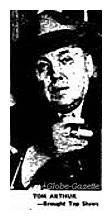 With Mason City directly
between Minneapolis and Des Moines, opportunity was provided to bring great stage productions here for one night stands. To
facilitate this Mason City had a born showman, Tom Arthur, who took over the management of the Wilson opera house Aug. 1,
1903.
With Mason City directly
between Minneapolis and Des Moines, opportunity was provided to bring great stage productions here for one night stands. To
facilitate this Mason City had a born showman, Tom Arthur, who took over the management of the Wilson opera house Aug. 1,
1903. As the population grew and the silent movies became popular, other theaters were started, the Bijou, Star and
Airdrome. In these, as well as the Cecil, vaudeville made periodic appearances.
NOTE: Tom Arthur was born in 1878, and died in 1955. His wife, Alice Arthur, was born in 1895, and died
in 1986. They were interred at Elmwood-St. Joseph Cemetery.
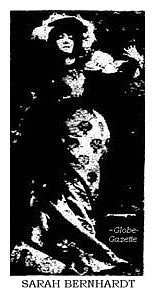 Of all the grand occasions in which stage celebrities came to Mason City, none exceeded the great Madame Sarah Bernhardt
in "Camille" in 1908 with Lou Tellegen playing the Armand role. The theater grossed $4,500 for one performance to set an
all time record in Mason City. She arrived on a special train from Sioux City.
Of all the grand occasions in which stage celebrities came to Mason City, none exceeded the great Madame Sarah Bernhardt
in "Camille" in 1908 with Lou Tellegen playing the Armand role. The theater grossed $4,500 for one performance to set an
all time record in Mason City. She arrived on a special train from Sioux City. NOTE: Sarah Bernhardt,
was born in October of 1844. Achieving early fame in her native France, she was heralded as "the most famous actress
the world has ever known." She died from uremia after suffering kidney failure on March 26, 1923.
SOURCE: http://en.wikipedia.org/wiki/Sarah_Bernhardt Fairbanks Performs
The next year William S. Hart, later to take tough roles in the movies, appeared in the title role of "The Virginian."
Also here that year was Douglas Fairbanks, almost a nonentity then, as well as the Pickfords, Mary Lottie and Jack, as
members of a company with Chauncey Alcott. Among the popular shows of this era were "The Old Homestead," "St. Elmo,"
"The Girl of the Golden West," "As You Like It," "Moulin Rouge," "Beverly of Graustark," "Cat and the Fiddle," "Romeo and
Juliet," and, of course, "Uncle Tom's Cabin." Sidney Drew, brother of the great John Drew, was starred in "Billy." One
night the Minneapolis Symphony Orchestra performed. Frank Gotch, world's heavyweight champion, tossed George Parker in a
wrestling match March 16, 1910, and then, because the first match was so short, threw Andy Anderson in a second bout.
Destroyed by Fire
NOTE: The Wilson Hotel and Theater, ca. 1910
On Halloween night, Oct. 31, 1911, the Wilson Opera House was destroyed by fire. Erected in its place was the beautiful
Cecil Theater, which staged a gala opening performance June 3, 1912, with "The Pink Lady" as the attraction and Olga
De Baugh, Josie Intropodi, Octava Crooke and Marguerite Wright the featured players. The troupe came to Mason City from
New York on a special train for the single show. Seats were sold at fabulous prices. May Robson, later a great film
star, came to the Cecil in "One Night Out," Nov. 29 of the same year, followed by Verdi's "Il Trovatore," by the San
Carlos Opera Company. In 1913 came Fritzi Scheff in "The Love Wager," Al Shean in "The Rose Maid" and on March 25 of that
year, "The Balkan Princess," in which Wallace Beery, of later movie fame, had a minor role. Maudie Adams appeared in
James M. Barrie's "Peter Pan" and the great Lillian Russell came later in the year, singing "Island of Roses and Dreams."
Here in "Salome"
 Sensuous, exotic Eva Tanguay played the Cecil March 2, 1914, in "Salome." She was the "it" girl of her day, long before
the word was publicized by Elinor Glynn. That same year, after the war had begun in Europe, the famed dancer, Ruth St.
Denis, appeared with her partner, Ted Shawn, and a company of dancers.
Sensuous, exotic Eva Tanguay played the Cecil March 2, 1914, in "Salome." She was the "it" girl of her day, long before
the word was publicized by Elinor Glynn. That same year, after the war had begun in Europe, the famed dancer, Ruth St.
Denis, appeared with her partner, Ted Shawn, and a company of dancers. Scotland's Harry Lauder made the first of
several local appearances that same season, singing "It's Nice to Get Up in the Morning, but It's Nicer to Lie in Bed." It
was in Mason City that Lauder was notified that his son, John, had gone to France to fight in the war. Two weeks
later he was killed in action. The latter part of the year, Fred Stone made his second visit to Mason City as a member
of the team Montgomery and Stone. They appeared with a troupe in "Lady of the Slipper." John Drew Here
But it was in 1916 - April 5, to be exact - that Mason City was honored by the greatest performance since
Sarah Bernhardt. John Drew came to Mason City in "Rosemary." He was an uncle of John, Lionel and Ethel Barrymore.
Fiske O' Hara made one of many local appearances on 1916 in "Kilkenny." In the cast was a girl named Ann Nichols, who
later made a fortune by penning "Abie's Irish Rose," which for many years held the record with five years on Broadway.
That play was offered to O'Hara, who refused it on advices of his managers. Mrs. Castle Here
Another 1916 theater highlight was Mrs. Vernon Castle, noted dancer, in "Watch Your Step." Here twice that year was
May Robson in "The Making Over of Mrs. Matt" and "The Rejuvenation of Aunt Mary." Walker Whiteside, another
great star of the day, was starred in "The Typhoon." Wilham Faversham, one of the stars of that era, had a leading role
in "The Hawk." Guy Bates Post, one of nation's favorites, played Omar Khayyamin "Omar, the Tent Maker."
Other notables of this period who performed in Mason City included William H. Crane, Sir Forbes-Robertson,Minne
Maddern Fiske and Cyril Maude. Maude was starred in "Grumpy" and Mrs. Fiske in "Rivals." Many Mason Cityans will
remember Taylor Holmes, who gave such an admirable performance of the role, Jeeter Lester, in "Tobacco Road" on May
11, 1937. That same Holmes made his first appearance on the Cecil stage in 1916 in the title role of "His Majesty,
Bunker Bean." War Has EffectBecause of the war there was a dearth of talent here in 1917.
One of the few stage attractions that year was the San Carlo Grand Opera Company, which presented "Aida." Also give
at that time was "Ben Hur," with Thomas Holdren in the leading role. Not until 1920 did plays return at their old
pace and by that time movies were threatening to push them off the stage. James Gleason came in "A Price There Was." May
Robson returned once again in "Nobody's Fool" and Lou Tellegen was seen in "Blind Youth." Guy Bates Post had the starring
role in "The Masquerader." Otis Skinner, father of Cornelia Otis Skinner, was starred in "At the Vilas Rose." One of the
gentlemen of the ensemble in a musical entitled, "Irene," was Ben Blue, later to rise to fame as an eccentric dancer and
comedian. In 1921 May Robson was again here in "It Pays to Smile."The great Russian ballet dancer, Anna Pavlowa, headed
the "Ballet Russe" in a marvelous performance. Frank Bacon, who later authored "Lightnin'," appeared here in "Fortune
Hunter," with Thomas Ross as the star. George White brought his troupe, the "George White's Scandals"and in the starring
role was Ann Pennington, noted dancer. Chauncey Alcott appeared in "Ragged Robin" and in "Mr. Pim Passes By."
In Lincoln PlayFrank McGlynn was here in the title role of "Abraham Lincoln." Chester Morris,
later to become a movie star, had the juvenile role in "So This Is London," presented in 1924. That same year Ruth
St. Denis and Ted Shawn made a return appearance and with them was Louise Brooks, silent screen movie actress. In the
cast of the delightful "Blossom Time" was Gregory Ratoff, one of the film's ace comedians. Margaret Anglin and
William Faversham were starred in "Foot-Loose" and a minor role was taken by Paul Porcasi, another future movie star.
Ed Wynn came to Mason City in his biggest stage hit, "The Perfect Fool." And thus, the long procession of theatrical
stars who graced the Cecil theater stage came to an end. Another entertainment medium was developing, the talking movie.
The age of flesh and blood entertainment was over. But while it lasted, it was truly a golden age.
Cecil Theater
Movies
Came in 1906
 Meanwhile a new medium of entertainment, motion pictures, had developed on South Federal, spearheaded by J. M.
[John McKee] Heffner,
who came to Mason City in 1905 and opened the Bijou on the present [1953] site of the Odd Lot store in 1906.
Meanwhile a new medium of entertainment, motion pictures, had developed on South Federal, spearheaded by J. M.
[John McKee] Heffner,
who came to Mason City in 1905 and opened the Bijou on the present [1953] site of the Odd Lot store in 1906. The first
seats were kitchen chairs. The operating room was over the ticket box, consisting of a platform with a railing around it.
The theater seated 200 and the program was so short that 1,000 could see the show in an afternoon. At first there were
no Sunday shows, but Heffner soon found this was what the public wanted. Sunday performances were against the law so
every Sunday evening for two years the police called on him and he wrote a check for $5 and costs ($8.35).
NOTE: John McKee Heffner died on March 27, 1956, with interment made at Memorial Park Cemetery.
Other Houses OpenAs soon as Heffner's venture proved a success and the public
became movie conscious, other movie houses opened. Across the street from the Bijou, Frank Humphrey and W. E. Millington
operated the Star, now [1953] Band Box Theater. In 1910 Heffner was joined by Tom Arthur in opening the Princess,
now [1953] the Strand. In 1912 P. E. Johannsen started the Orpheum on the present [1953] Hughes store site and two
years later opened the Regent, now [1953] the Palace Theater. The Cozy Theater in the 1100 block on North Federal and
the Idle Hour, on the present [1953] Kresge 10 Cent Store site, had only brief runs. The name of the Princess was changed
to Casino and then the Garden, including vaudeville with the movies. M. B. Tournier purchased the Star.
In the early 20's the A. H. Blank Interests in Des Moines acquired the Palace and the Strand. Heffner took over the
management. Later Tom Arthur joined with the Blanks and managed for a time the Palace and Strand together with his
own Cecil Theater.
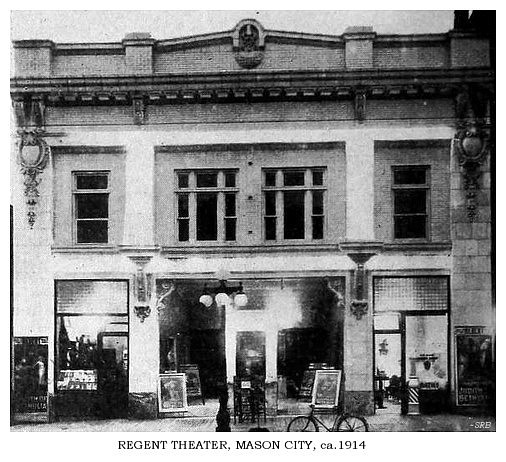
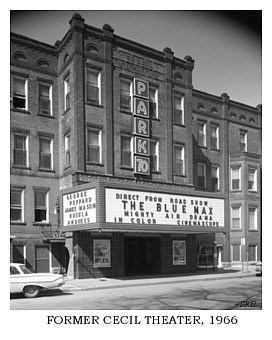 NOTE: Maynard R. Tournier
was born in 1875, and died in 1919, interment made at Elmwood-St. Joseph Cemetery.
NOTE: Maynard R. Tournier
was born in 1875, and died in 1919, interment made at Elmwood-St. Joseph Cemetery.
William Edward Millington was born in 1865, and died in 1965. Carrie Alice
Millington, his wife, was born in Illinois, 1870, and died in 1939. They were interred at Elmwood-St. Joseph Cemetery.
The Star (State) Theater opened in the early 1940's with a seating capacity of 532, at 120 S. Federal Avenue. Manager Nathan
Miller sold the theater to C. A. Shultz and it was renamed
the Band Box Theater, It reopened in July of 1951 with new seats, new carpeting, new projection and sound, and had an
11-foot snack bar and air-conditioning. The snack bar featured a bottle warmer for the "convenience of mothers
attending the theater with small babies." Harry Miller was named as the new manager. Miller had previously been the manager for the
State Theater. CinemaScope was installed in 1955.
The Band Box theater closed with its last ad appearing on December 11, 1956 and was later demolished.
The Regent Theater, 110 S. Federal Avenue, had a seating capacity of 786. It was renamed The Palace Theater sometime in
the early 1920's. The Palace hosted the world premiere of "The Music Man" on June 19, 1962. The entire cast of the
movie, along with Meredith Willson, traveled to Mason City for the event. Willson headed a 3-hour long parade with a total
of 8,000 bandsmen. Approximately 125,000 people were in Mason City for the event. After the showing at the Palace
Theater, a premiere party was held at the Hotel Hanford. The Palace closed in the mid-1980's.
Originally known as the Princess Theater, located on 206 S. Federal Avenue, was renamed the Strand Theater in 1935. It
had a seating capacity of 568. The Strand closed its doors in 1975 and was ultimately demolished.
The Cecil Theater, adjacent to the Eadmar Hotel at 16 N. Washington Avenue,
opened in the mid-1920's with a seating capacity of 859. It was the largest of the seven theaters
that were at one time located in downtown Mason City. It was first operated by Central States Theater, then by the Cerro
Gordo Hotel Company in the 1980's. By 1986 the theater was known as the Park 70 Theater. In its final years, it operated
as an adult theater. After the property had been abandoned for a period of several years, it collapsed in 1988.
THEATER INFORMATION SOURCE: cinematreasures.org/theaters

* * * * * * * * * * * * * * * * * * * * * * * * *
THE CONSCIENCE of the COMMUNITY
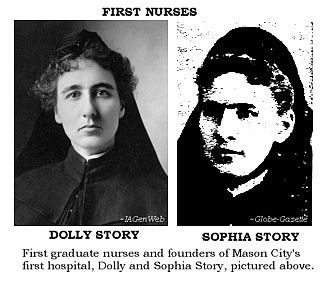 [Section 7, Page 30] One night in the early fall of 1892, the slim, trim figure of a young woman, Sophia
Story, stepped on the eastbound Milwaukee train for Chicago.
[Section 7, Page 30] One night in the early fall of 1892, the slim, trim figure of a young woman, Sophia
Story, stepped on the eastbound Milwaukee train for Chicago. It was an uneventful occasion except for the Story family. To
Mason City it was to prove the beginning of something new. Sophia was on her way to study nursing at the Michael Reese
Hospital in Chicago. Sophia, up to then, had taught school from the time she and her three sisters and three brothers
and her mother arrived from Boone County in that memorable year, 1876, when the nation was observing the centennial of
the signing of the Declaration of Independence. Killed in WarSophia's father had been killed
in the Civil War, leaving the large family to carry on. Mrs. Story and the children placed all their household goods and
farm implements in two covered wagons and came to a farm north of Mason City to make their home. While the boys farmed
the girls turned to teaching and sewing until Sophia's sudden inspiration to become a nurse. That decision proved a
turning point in the lives of all the feminine members of the family. It was to do more than that. It provided Mason City
with its first hospital. It gave a new impetus to the slowly developing consciousness of man's concern for man that
was to find its expression in numerous public and private projects over the decades that followed. Sophia was followed
to Michael Reese by her younger sister, Dolly. Both returned to Mason City, Sophia in 1895 and Dolly in 1897, to provide
the community with nursing service at $3 a day. Nurses in those days were on duty 24 hours a day. Open
HospitalBy 1901 the sisters acquired sufficient funds to purchase the large house at 107 Pennsylvania
N. E., where they opened a hospital with 16 rooms. The hospital became a project in which all the women of the family
participated. The mother, Mrs. Charlotte Story, became the seamstress. Mary, the oldest daughter, who became Mrs. T. M.
Fulghum, helped. Another daughter, Adelia, became part of the staff. Compassion for the sick and the injured, the
realization that it was meeting a great community need, spurred the Story family on. In order to insure needed income
for new equipment the two graduate nurses changed off on doing private nursing service. Industries in those days did
not place the emphasis on safety they do today. Men were constantly being injured on the railroad or in the brick yards.
First Patients Arrive
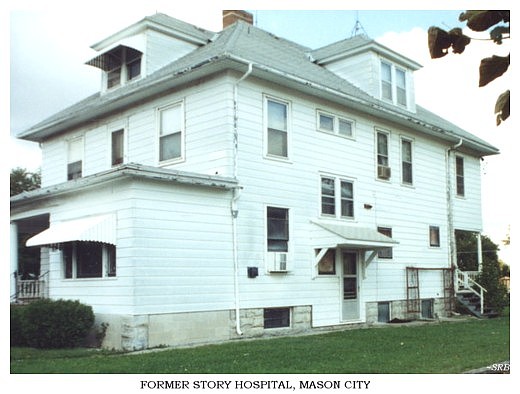 On Nov. 18, 1901, the first two patients were brought to the hospital - one
an insanity case and the other an intoxication and dope addict. Both patients challenged the ingenuity of the nurses, but
this proved the beginning of an exciting life that continued until 1938, when the hospital was closed and the building made
into apartments. By that time larger hospitals were in operation carrying on the work so ably started by the Story sisters.
On Nov. 18, 1901, the first two patients were brought to the hospital - one
an insanity case and the other an intoxication and dope addict. Both patients challenged the ingenuity of the nurses, but
this proved the beginning of an exciting life that continued until 1938, when the hospital was closed and the building made
into apartments. By that time larger hospitals were in operation carrying on the work so ably started by the Story sisters.
The pioneer physicians who practiced in the community found it a struggle to remain in practice. The sturdy settler was
reluctant to call for medical help
except as a last resort. Fees were small and a number of physicians only remained here
a year or two.
NOTE: Rollin Gardner Story was born in Bennington County, Vermont, served as a Private with Co.K of the
95th Illinois Infantry during the Civil War. He was killed while in service when a train ran over him December 20, 1864, Nashville,
Tennessee, interment was made at Nashville National Cemetery. His wife, Charlotte Melvina (Knox) Story, was born May
25, 1828, and died March 18, 1918, interment was made at Elmwood-St. Joseph Cemetery. Their children:
Loring U. Story, born February 28, 1849, died August 22, 1900, interment Elmwood-St. Joseph Cemetery
Clarrisa Fidelia "Del" Story, born 1851, Boone Co. IL, died May 19, 1938, Mason City, inter. Elmwood-St. Joseph Cemetery
Orris Justin Story, born Jan. 21, 1853, Marengo IL, died Oct. 21, 1934, Hubbard Co. MN where he was interred
Fred E. Story, born July 27 1955, died January 14, 1918, interment Elmwood-St. Joseph Cemetery
Sophia Story, born November 31, 1859, died December 7, 1924, interment Elmwood-St. Joseph Cemetery
Mary (Story) Fulghum, born August 10, 1861, died June 7, 1959, interment Elmwood-St. Joseph Cemetery
Dolly Lorraine (Story) Bushell, born April 30, 1863, Boone Co. IL, died 1956, Mason City, interment Elmwood-St. Joseph Cemetery
Organized Medical SocietyIn 1871, however, Dr. A. A. Noyes organized the
Cerro Gordo Medical Society, which has continued as a potent organization to the present. Among the prominent
physicians in the early years was Dr. J. B. Dakin, who came to Mason City in 1869,, Dr. Shorland Harris, physician and
druggist, came to Mason City in 1869 and operated one of the first drug stores in the town. Dr. C. H. Smith came in
1879 and Dr. O. A. Goodhue started practice in 1870 [1880?]. Other doctors of the 80's were Dr. Edward Osborne, Dr.
F. M. Somers, Dr. A. L. Wheeler and Dr. T. M. Blythe, brother of James E. Blythe, Mason City attorney. They were
followed by Dr. W. G. Egloff, Dr. J. E. McDonald, Dr. E. McEwen, Dr. F. E. McGlone, Dr. F. G. Murphy, Dr. C. M. Swale,
Dr. B. F. Weston and Dr. Stella Mason, who started practice in 1893.
NOTE: Dr. James B. Dakin was born January 5, 1825, served during the Civil War, and died
March 1, 1896, interment was made at Elmwood-St. Joseph Cemetery.
Dr. Shorland Harris was born July 17, 1829, Ilfracombe,
England, served in the Crimean War, came to America in 1853, and died January 1, 1905, interment made at Elmwood-St.
Joseph Cemetery.
Dr. Chauncey H. Smith was born March 26, 1837, and died February 25, 1909. His wife, Martha Janet (Allen)
Smith, was born December 12, 1838, and died January 23, 1904. They were interred at Elmwood-St. Joseph Cemetery.
Dr. Thomas Moore Blythe was born December 28,1857, Vincennes, Indiana, left Mason City in November of1887 for
California, and died March 5, 1945, San Bernardino County, California. Imogene (Carrier) Blythe, his wife, was born
May 19,1861, and died December 28, 1947, San Bernardino County, California. They were interred at Hillside Memorial Park,
Redlands, California.
James E. McDonald was born in 1867, and died in 1953, interment made at Elmwood-St. Joseph
Cemetery.
Dr. Earle McEwen was born July 31, 1857, and died February 17, 1939, interment made at Elmwood-St.
Joseph Cemetery.
Dr. Francis E. McGlone was born February 2, 1868, and died November 21, 1929, interment made at
Saint Patrick's Catholic Cemetery, Dougherty.
Dr. Clarence Milton Swale was born in 1871, and died in 1915. Lilian
C. Swale, his wife, was born in 1880, and died in 1921. They were interred at Elmwood-St. Joseph Cemetery.
Dr. Burton F. Weston was died November 18, 1933, interment made at Memorial Park Cemetery.
Got EncouragementIt was some of the latter of these who provided the encouragement for the
Story sisters' hospital venture, particularly Dr. Smith, Dr. Egloff, Dr. Stockman, Dr. Swale, father of Doug Swale,
and Dr. C. L. Marston. When the hospital went into operation several others, both in Mason City and the surrounding
area, brought their patients, including Dr. C. E. Dakin, Dr. V. A. Farrell, Dr. T. T. Blaise and others.
NOTE: Dr. Charles L. Marston was born February 6, 1870, served with the American Expeditary
Forces as a Lieutenant-Colonel with the Field Hospital Corps, and died June 25, 1942, interment made at Elmwood-St. Joseph
Cemetery.
Dr. Vincent A. Farrell was born in 1876, and died in 1936. Marie (Gregory) Farrell, his wife, was
born in 1877, and died in 1965. They were interred at Elmwood-St. Jospeh Cemetery.
Dr. Thodore Thomas Blaise
died May 15, 1931, interment made at Memorial Park Cemetery. In time the Storys had to hire additional
nurses. First to join the tightly knit family group was Hattie Lymenstahl, who later became school nurse. She also got
her degree from Michael Reese. NOTE: Hattie B. Lymenstahl was born June 15, 1882, and died August 9, 1976,
interment made at Memorial Park Cemetery. Patients too ill to be moved were nursed in their own
homes." "Many a time we've sterilized our dressings and utensils in a cracked boiler with the dressings being fastened
to the top of it," the sisters used to say. Open Park Hospital
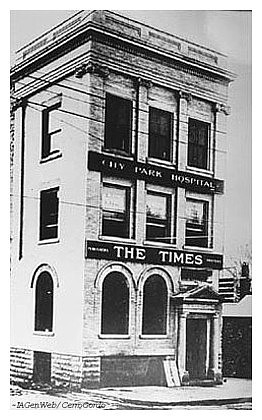 As the community underwent its forward surge in population, the need for more hospital facilities became apparent. In 1909
a group of seven physicians organized a staff and built the 50 bed Park Hospital.
As the community underwent its forward surge in population, the need for more hospital facilities became apparent. In 1909
a group of seven physicians organized a staff and built the 50 bed Park Hospital. The founders of the hospital were:
Dr. C. F. Starr, Dr. Fred Albert, Dr. C. M. Swale, Dr. Frank F. Murphy, Dr. L. E. Newcomer, Dr. M. J. Fitzpatrick and
Dr. W. E. Long. Soon afterwards Dr. George M. Crabb joined the group and with the years came a number of other physicians to enlarge
the staff. In 1938 the Park Hospital added another wing at a cost of $25,000, providing additional room for X-ray and
surgery. Later the administrative offices were enlarged and the most modern equipment installed.
NOTE: Dr. Charles Freeman Starr was born December 13, 1876, and died January 28, 1968, interment
made at Memorial Park Cemetery.
Dr. Mathew J. Fitzpatrick was born at Elkader, Iowa, September 20, 1885, and
died May 20, 1928, Mason City. His wife, Inez B. Fitzpatrick, was born April 18, 1889, and died February 3, 1920. They
were interred at Elmwood-St. Joseph Cemetery.
Dr. William E. Long was born in 1870, and died in 1937. Sue E. (Lyon)
Long, his wife, was born in 1878, and died in 1963. They were interred at Elmwood-St. Joseph Cemetery.
Park Hospital
In 1915 Mason City's recognition as a hospital center in North Iowa became further established with the building of St.
Joseph's Mercy Hospital. Graduation in 1918
The initial building of St. Joseph's Mercy Hospital provided 120 patient beds and living quarters for the nurses.
The hospital was opened Dec. 9, 1915, by Sisters from the Motherhouse in Dubuque, Mother Agnes coming with Sister Mary
Vitalis, Sister Mary Catherine and Sister Mary Stanislaus. On Dec. 17, 1915, Sister Mary Thaddeus came as director of
nurses and a school of nursing was opened Sept. 27, 1916. The first graduation was held Dec. 12, 1918. Throughout the
years the hospital continued to add to its equipment and capacity to provide for patients. The nurses' residence and
educational building was erected in 1925. A new wing was added in 1941, increasing the capacity to 211 patient
beds and 54 new borns. NOTE: Park Hospital was renamed North Iowa Medical Center and moved
from downtown Mason City to the west side. In 1993, St. Joseph's Mercy Hospital and North Iowa Medical Center
consolidated as North Iowa Mercy Health Center, now [2014] known as Mercy Medical Center - North Iowa located at
1000 4th Street S.W. SOURCE: http://www.mercynorthiowa.com/history
Lodges OrganizedMeanwhile other expressions of man's concern for his fellow being were crystallizing.
Lodges with programs providing for the care of the aged and orphans took form. Dominant in the life of the community
from the start was the Masonic Lodge, followed closely by the Odd Fellows. In time Mason City became the leading
center of the IOOF to the extent that in October, 1900, the local group asked the Grand Lodge to locate the proposed
orphan's home here. The cornerstone for the home was laid May 14, 1932, and on May 20, 1903, dedication of the building
took place. Disaster struck three years later when the building was destroyed by fire. In 1912 the old people's home
was built and in 1923 it was doubled in size. In 1924 a 16-bed hospital was added to the facilities of the home. Later
as the needs for orphans of members of the lodge lessened, the home opened its doors to the children of GI's and also
made itself available for children assigned by court orders.
Membership IncreasedMembership and activities of lodges reached their apex in the opening
decades of the 20th century. World War I served as an added impetus to lodge membership. Other fraternal orders that had
sizeable memberships were the Benevolent and Protective Order of Elks, Knights of Columbus, Catholic Daughters of America,
Fraternal Order of Eagles, Loyal Order of Moose, Knights of Pythias, Modern Woodmen of America, Royal Neighbors of
America, Tribe of Ben Hur and Woodmen of the World. But lodges have meant more than the expression of brotherhood to
Mason City. Their existence has been of tremendous importance to the commercial life of the city. Because of this Mason
City's growing Commercial Club was active in their support. Pledged $4,000
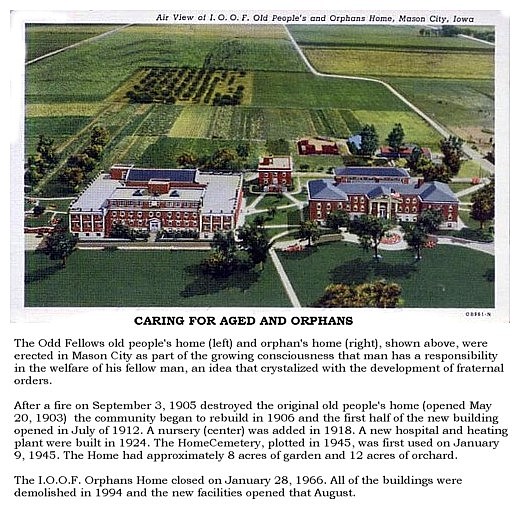 It was a $4,000
pledge by the Commercial Club for the purchase of a farm site south of Mason City that assured the IOOF orphans and
old peoples home in this community.
It was a $4,000
pledge by the Commercial Club for the purchase of a farm site south of Mason City that assured the IOOF orphans and
old peoples home in this community. In 1901 an enterprising group of Mason City business men attended a meeting of
the Modern Brotherhood of America and sold the embryo organization, formed in Tipton, Iowa, four years before, on moving
its headquarters to Mason City. That same year Eugene L. Balz was elected supreme secretary of the lodge. Almost from
the first, Balz, together with a growing membership among the businessmen of the city, advocated the erection of an
office building to anchor the lodge to Mason City. Until this was accomplished there was a battle at every convention
of the supreme lodge to moved head offices elsewhere. In 1908 the Commercial Club raised $606.50 to send a
committee to such a convention at Davenport, where a successful battle was fought to hold the organization in Mason
City.
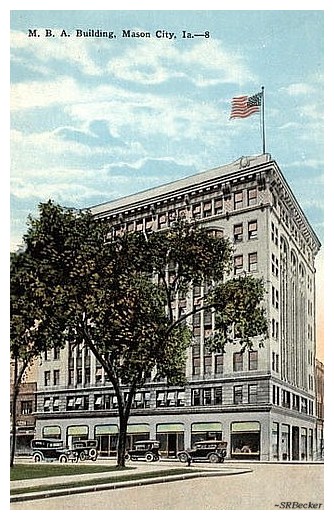 After the Davenport meeting, Balz and his Mason City friends redoubled their efforts for the erection of an MBA office
building which resulted in the construction in 1916 of the present Brick and Tile Building. [Prior to the erection of
this building, The Elks Lodge was located on this site. Designed by architects Bell and Bentley of Minneapolis,
construction on the building began on May 18, 1916.]
After the Davenport meeting, Balz and his Mason City friends redoubled their efforts for the erection of an MBA office
building which resulted in the construction in 1916 of the present Brick and Tile Building. [Prior to the erection of
this building, The Elks Lodge was located on this site. Designed by architects Bell and Bentley of Minneapolis,
construction on the building began on May 18, 1916.] Two days, June 6 and 7, 1917,
were devoted to the dedication of the building, with William Howard Taft as the chief speaker. The builders viewed
with deserving pride the structure that stood as a lasting symbol of a triumph drama that started with the bringing
of the lodge to Mason City 16 years before. But those who built didn't know the denouncement of their drama was
approaching and that it was to end in tragedy. Balz Voted OutIn 1923 Balz, who had been
the dynamic spearhead of the organization, was voted out in a historical factional fight. Not long afterwards the MBA
was absorbed by the Independent Order of Foresters, a Canadian fraternity, out of which grew revelations of fraud. The
order made a sad, tragic exit out of the lives of the people of Mason City, but left an enduring monument. On April 1,
1948, the Mason City Brick and Tile Company purchased the building. NOTE: The eight-story
MBA/Brick and Tile Building was sold in 1973 to State Street Investment and was renovated. The building was sold
again in 2000 to Brian Crane. It was placed on the National Register of Historic Places September 12, 2002.
* * * * * * * * * * * * * * * * * * * * * * * * *
Unless otherwise noted, photographs courtesy of The Globe-Gazette.
Some of the photographs did not scan well. In such a case the photograph
has
been substituted with a clearer copy if available.
Transcriptions and Notes by Sharon R. Becker, December of 2014
Information obtained in notes from cemetery transcriptions, obituaries,
biographies & other Globe-Gazette articles
| 

